On the Atlantic shore of Morocco, Casablanca has been since the beginning of the nineteenth century an important point of settlement for the country’s Jews, and for those who came from the rest of North Africa or Europe to participate in the vertiginous modernization of the city that coincided with the French colonization. The Jewish presence was not at the center of the research I started around 1986, which led to the publication of a rather thick book that came out in France in 1998, and three years later in the United States, but could be felt throughout its pages.1 Nicknamed “the Bible” by its Casablancan readers, the volume analyzed the major urban spaces and buildings of the city and discussed their genesis. It gave back to its residents a certain pride against the dismissive attitude of Moroccans from historical cities like Fez, Meknès, Marrakesh and Rabat, since the inhabitants of this largely modern city had been long considered by their fellow countrymen exceedingly secular, business-oriented and alienated from traditional culture. They were in short, looked upon as Angelenos are seen by Bostonians, to use an American cliché. The book has contributed to strengthening the identity of all the groups that identify with Casablanca, from its Moroccan residents—Muslim and Jewish alike—to its former inhabitants living in France or scattered across all continents.
In her introduction to the lecture on which the present essay is based, Marie-Pierre Ulloa has mentioned my grandfather Marcel Cohen’s important role in the study of Semitic languages and the doctoral thesis he wrote in 1911 on the Arabic Parlance of Algiers Jews.2 However, I have not been drawn to Casablanca by a genetic attraction. Whereas at least two of my ancestors had left Tetuan for Marseille in the late eighteenth century, all my grandparents were born in Paris, the city where I sprung to life. Likewise, the origin of my scholarly interest for the city doesn’t derive from the aura it has acquired through Michael Curtiz’ homonymous picture of 1942, but rather from its discussion in the historical literature on urban planning, which has commented on Casablanca as an experimental territory, where modern strategies first emerged under French colonial rule, far from Paris—the center of the Empire.
The book was researched and written together with an ex-colonized Moroccan my then wife and colleague Monique Eleb, whose parents were from Safi and Mogador—the Portuguese name of Essaouira. She had left Morocco in the early 1960s but had a fond memory of the city and her recollections of its neighborhoods and the local mores were invaluable. Among the triggers that prompted us to engage in some twelve years of field work and writing were our reactions to the work of many of our Moroccan students in Paris. On the one hand we were fed up with the compassionate yet obsessive focus of most of them on the city’s shantytowns, but on the other we were attracted to the remarkable buildings a few others were discussing. Driven by curiosity, we started looking at the city with an attention which soon became systematic. The book had started us. And we tried to go beyond our fascination in order to decipher a city which was extremely seductive, but at the same time rather obscure in the absence of any serious literature about its genesis, development, morphology, or the typology of its buildings. In a way, we ended up writing the book we would have desired to find.3 The present essay dwells on the research made during the preparation of this volume, in which we deliberately focused on the Protectorate and its immediate aftermath, referring mostly to the five decades of the twentieth century and therefore leaving aside the most recent developments.
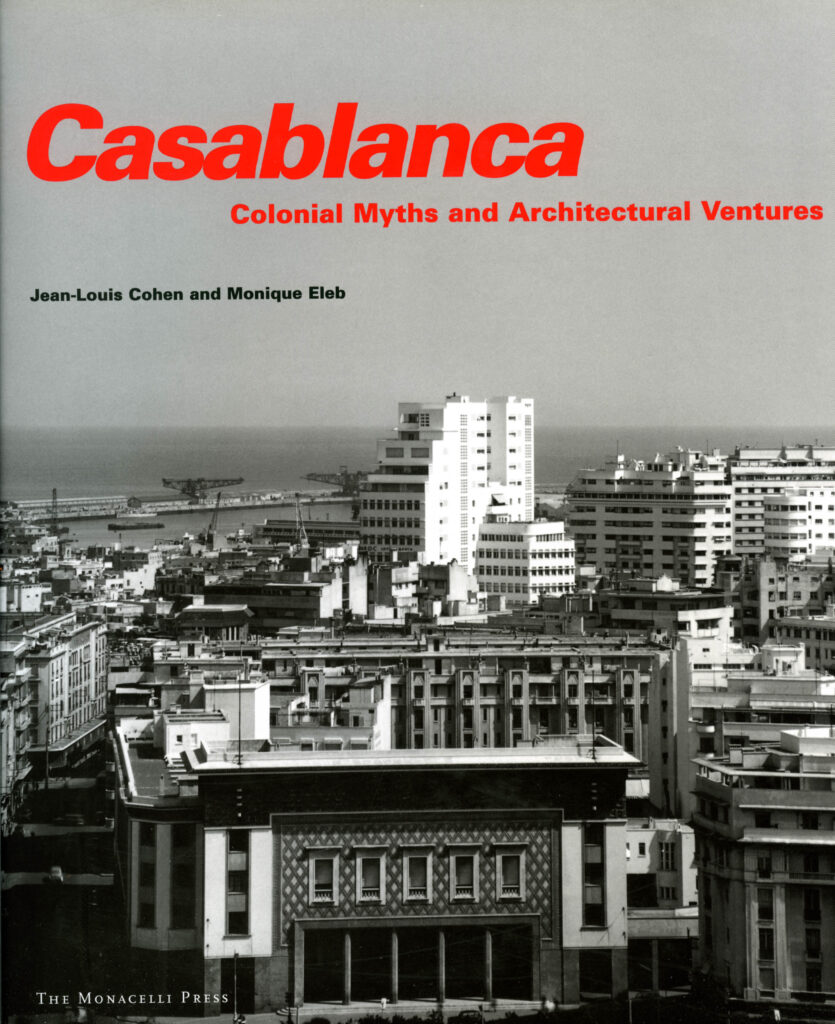
One of my favorite representations of the city is a 1920s poster meant to draw tourists to North Africa, which shows Casablanca as a gateway to Morocco. But this stylized opening is in fact a Janus gate with twin faces: one threshold which leads from the external world to a white city open to thousands of investors and migrants, who aspire to a better life in North Africa, as well as one leading rural Moroccans toward urbanization and industrial labor, and toward a certain freedom with respect to the constraints of village life. The poster indexes a process which started even before the creation of the French Protectorate in 1912, when Muslim and Jewish Moroccans flocked in large masses into Casablanca without being initially expected. The latter, who were already numerous in the precolonial city, became a driving force in the creation of the new town.
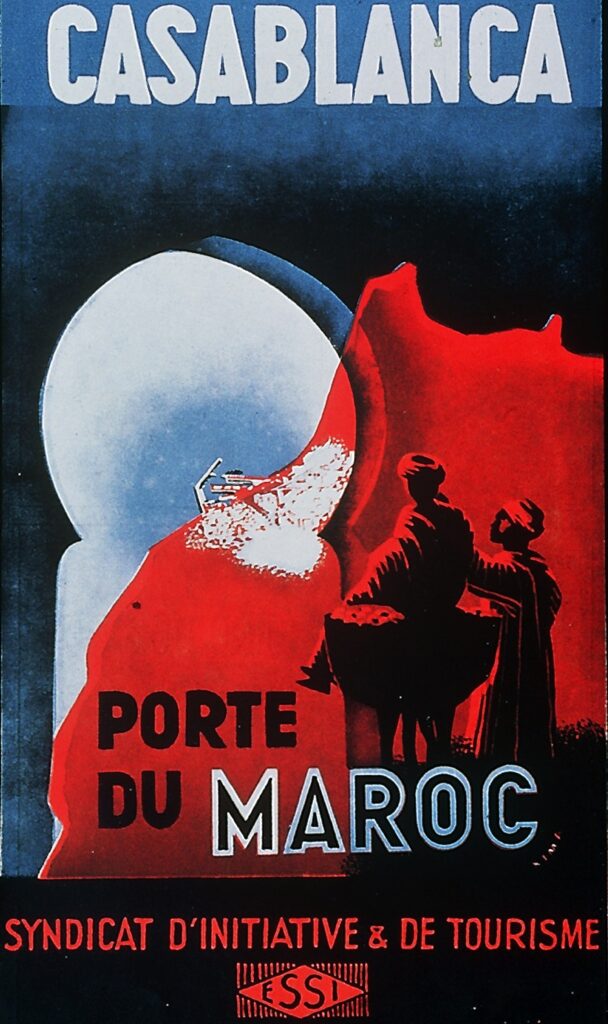
For several decades, Casablanca was advertised as a mushrooming city, as can be seen from the cover of a brochure from the early 1920s titled Les Villes qui poussent (Cities that Grow), which also uses the image of the gate, this time with a more sophisticated pattern inspired by Fez. The city did indeed grow.
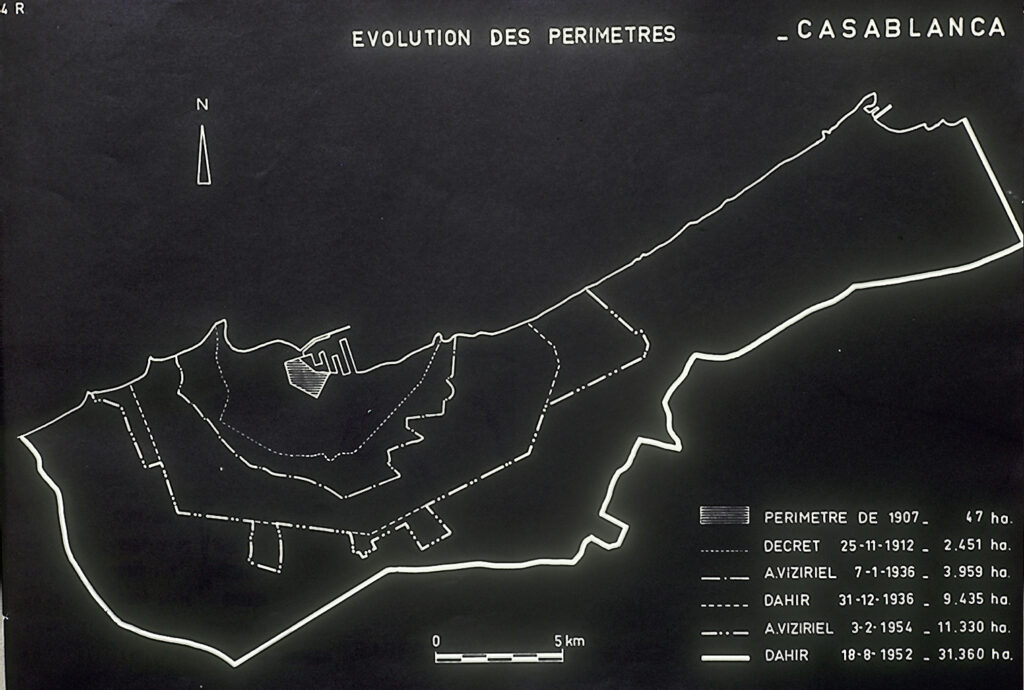
Fig. 3. Casablanca: urban expansion from 1907 to 1952. Collection of the author.
The small walled medina as it existed in 1907, when the French troops landed, occupying 47 hectares, expanded into an urban area of more than 31,000 hectares in 1954. The history of the vertiginous development which took place between the institution of the Protectorate and Morocco’s regaining of independence in 1956 had been in many ways simplified, as we realized while doing our research and writing our book. It had been often reduced to an exclusive confrontation between the French and the Muslim population, leaving aside the Jewish component, which had remained marginal in most narratives, until the most recent contributions.4 Even reliable, engaged scholars such as André Adam, who in 1968 had published a fundamental study on the population of Casablanca and its evolution during the colonial period,5 quite explicitly left aside the question of the Jews, a rather strange move for someone who had scientific scruples and no nostalgia for the colonization period.
Often put forward by the French as a completely new town, Casablanca was in fact an urban recreation that had taken place in the eighteenth century, on the spot where an ancient city called Anfa had stood until an earthquake wiped it out at the end of the fifteenth century. The city was left in ruins, as shown by a beautiful engraving published in 1572 by Georg Braun and Franz Hogenberg in their Civitates orbis terrarum.6
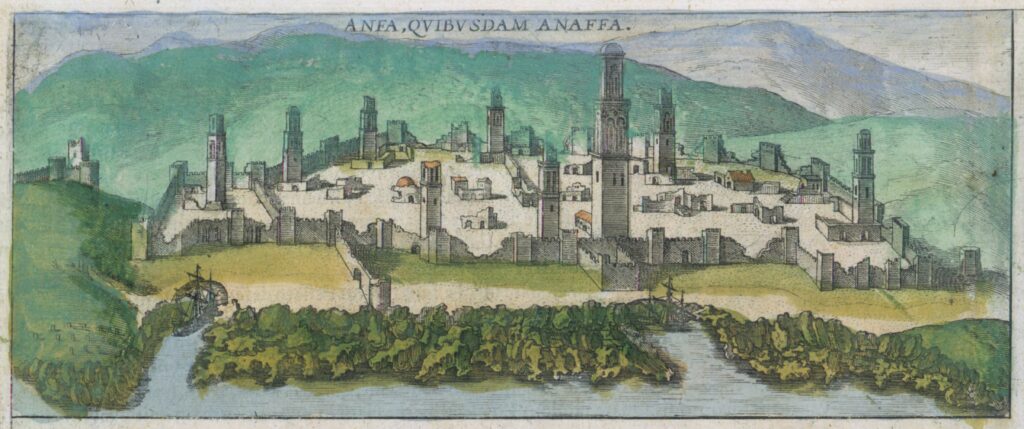
Fig. 1. The ruins of Anfa, in Georg Braun and Franz Hogenberg, Civitates orbis terrarium (1572). In Cohen and Eleb, Casablanca.
It shows a landscape of devastation, with a minuscule bay—the port which was still there when King Sidi Mohammed Ben Abdallah revived the city in the first third of the eighteenth century. It grew quickly, essentially as a place of trade, largely populated by foreigners. Around 1900, shortly before colonization, a map drawn by the French physician Félix Weisgerber indicates three distinct areas: the Muslim city itself, an area called the Mellah—a historical term denoting Jewish quarters in Moroccan cities, but here rather porous and less segregated than in other cities—and the area known as the Tnaker, made up of straw huts for the poorest inhabitants.7 A large area had been set aside for a future European population, in the tradition of Moroccan cities where growth used to be accomplished by discrete increments, as in the case of Fez.8 Postcards for the European market provide a clear view of the different areas of the city, with the skyline punctuated by the minarets of the mosques.
In this extremely dense walled city, Europeans and Moroccan Jews outnumbered Muslims. Jews had already started settling in Casablanca in the second part of the nineteenth century, after the memorable trip made in 1864 by the British philanthropist Moses Montefiore, who obtained and negotiated protégé status for Moroccan Jews in certain cities.9 Accordingly, European powers became the guarantors of the Jews who established businesses in Casablanca. At the same time, Jews remained subject to the dhimma, the Islamic law protecting them as well as Christians. One of its provision was that they might not build houses higher than the Muslim houses, and that the synagogues might not be higher than the mosques. They might not own more land than their own residence.10 This condition determined the development of Casablanca, because the Jewish financiers who lent money to Muslim merchants or aristocrats used as collateral pieces of land they could not occupy, much less build upon. They had immense wealth frozen in virtual real estate they could not really use.
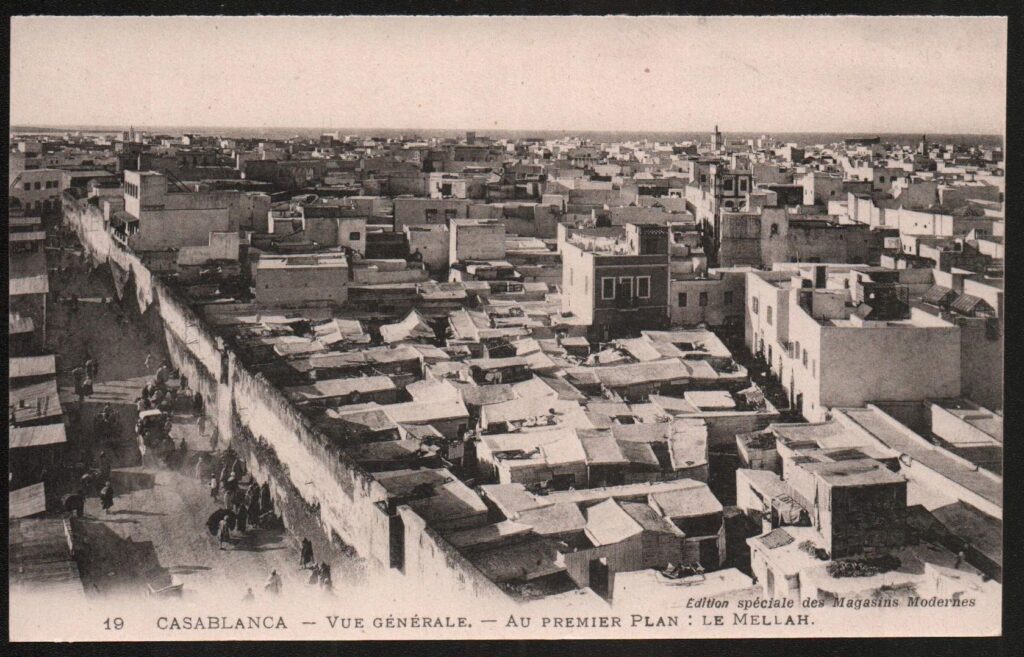
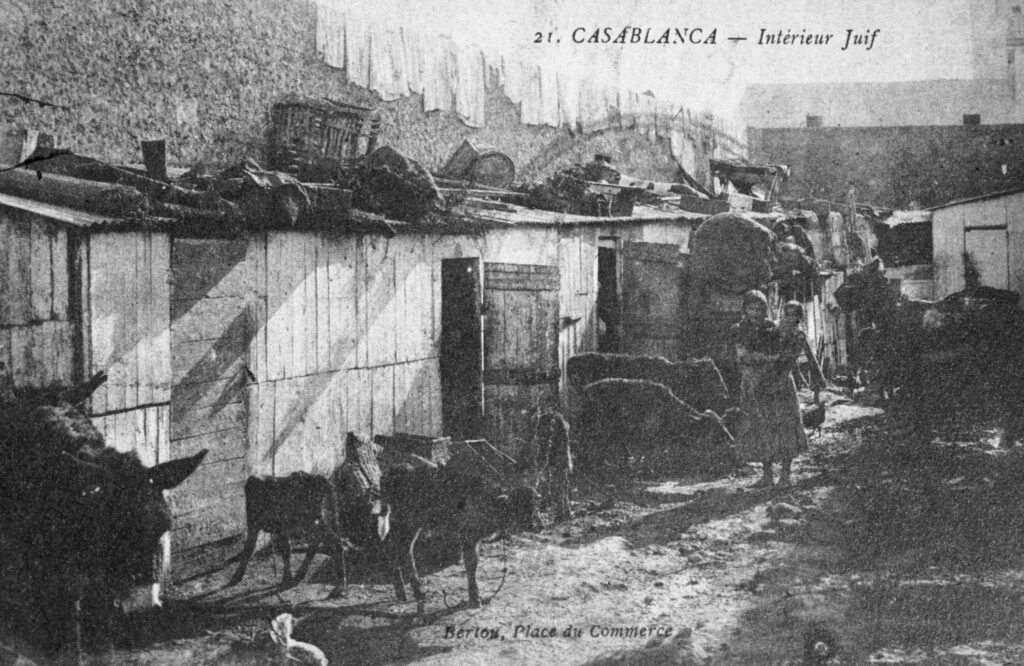
After the French navy landed in 1907, the city was surveyed and new rules on real estate were introduced, allowing Jews to become full owners of the land to which they had hitherto useless titles. The residences of the wealthiest families of the Mellah contained European interiors, as the correspondent of The London Times noted: “Several Jews have built huge apartment blocks which would not be out of place in Tübingen or in the suburbs of Cologne. They contain a number of fine apartments furnished in the Stuttgart and Bremen style, with sweeping views of the port.”11 This German imprint in these houses could not be grasped from the postcards, which insisted on the more miserable component of the Jewish population, sometimes in an ironic and dismissive way. This reference to Germany is of particular interest, because at the time France and Germany were still fighting over Morocco and did so until 1911 when the former’s hegemony over Morocco was acknowledged, in exchange for concessions to the latter in Equatorial Africa. After the outbreak of World War One, the competition with the Germans was finally solved by the expulsion of several merchants and the execution of the most conspicuous of them.12 Among the effects of the French landing of 1907 and the bombing of the city were the destruction of part of the Mellah and significant casualties among the Jews. Nonetheless, the French racist and anti-Semitic right was very quick to publish pamphlets against the “unfair” part Jews were taking in the colonization and development of Morocco. Jean Hess’ book Israël au Maroc was among the most vibrant of these publications in claiming that France was unfairly privileging Jewish investors and landowners.13
The first measures the French took in Casablanca were highly symbolic. Major Dessigny created a public garden and built a clock tower on the model of the one he had erected in the Algerian town of Aïn Sefra. Many patterns in the development of the city were introduced by civil servants and officers who had been active in Algeria. The new clock brought to Casablanca a unified time. Prior to that, the city was living according to British time, the Spanish navy time, and Moroccan time, measured from dawn to sunset. In 1915, Albert Laprade used an Andalusian-themed decoration for the lighthouse that had been erected on the shore. If one adds to these the tower of the railway station, the city entered the modern age with a series of high-rise structures, new minarets which quickly became part of its image. A poster designed by Édouard Brindeau around 1925 shows the clock tower standing against the old city, which no longer appears as a nebulous white mass, but as a lively urban landscape, under the gaze of a Moroccan woman who is located in an imaginary terrace suspended in the air.
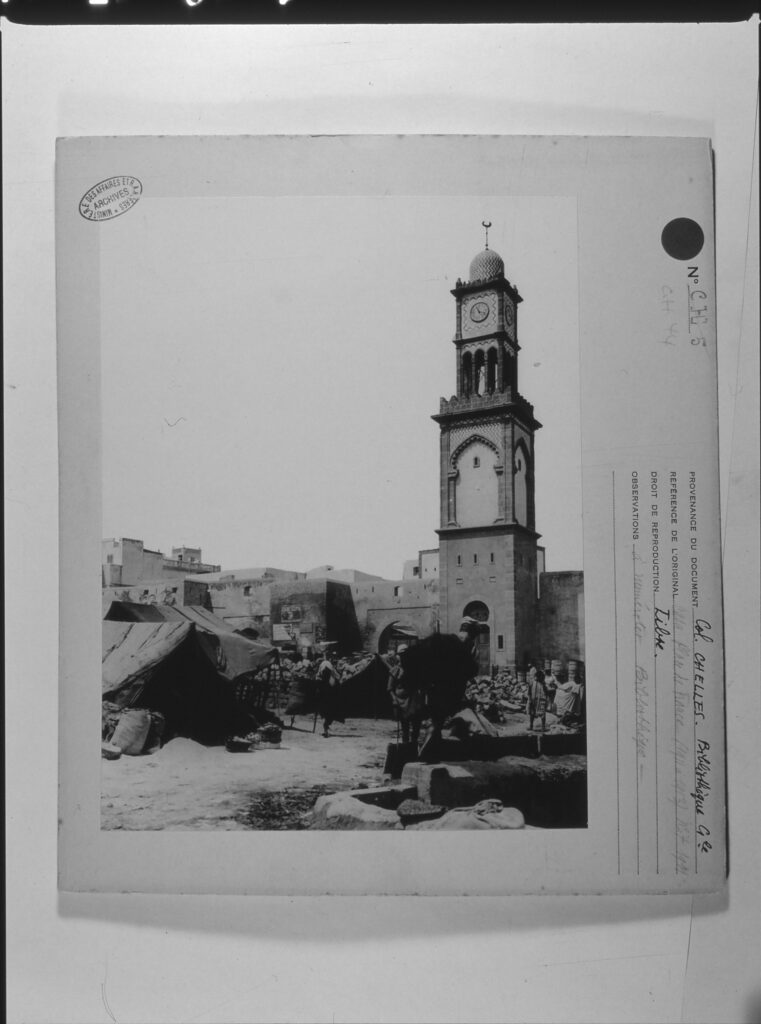
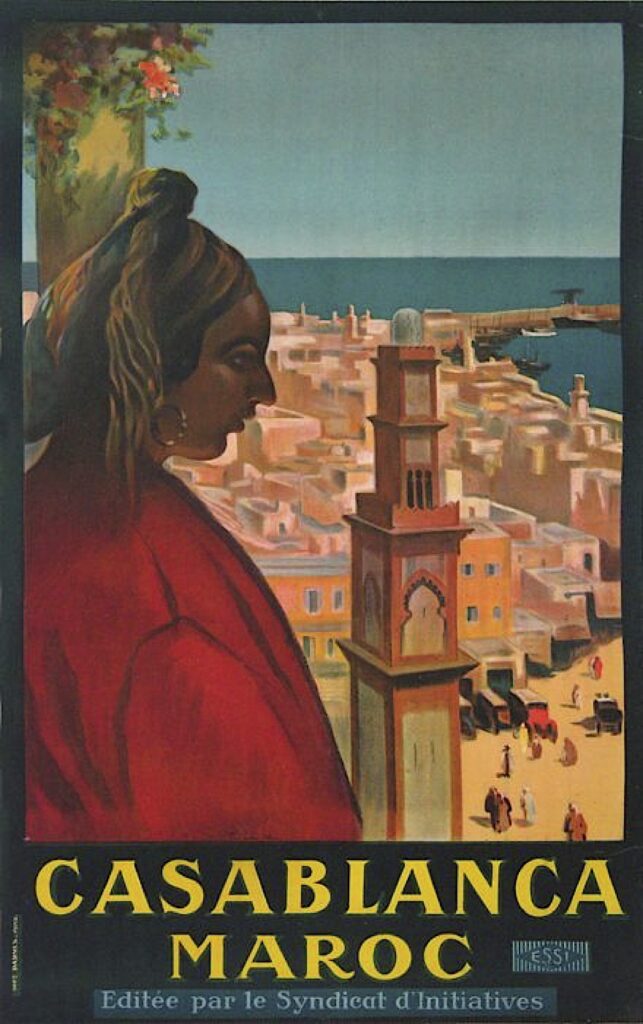
After an intense press campaign orchestrated in Europe by the French conquerors put it on the map, investors and developers lost no time in trying to secure land for real estate ventures. A first expansion plan was drafted in 1912 by the surveyor Albert Tardif, who proposed a garden suburb in the South. At the same time, the Jews started leaving the Mellah to settle in the new town, building their homes alongside the former rural paths. Clusters of new houses occupied entire blocks outside the walls, without any comprehensive planning, using ground pieces which had been acquired previously as collateral for loans given to Muslim borrowers.
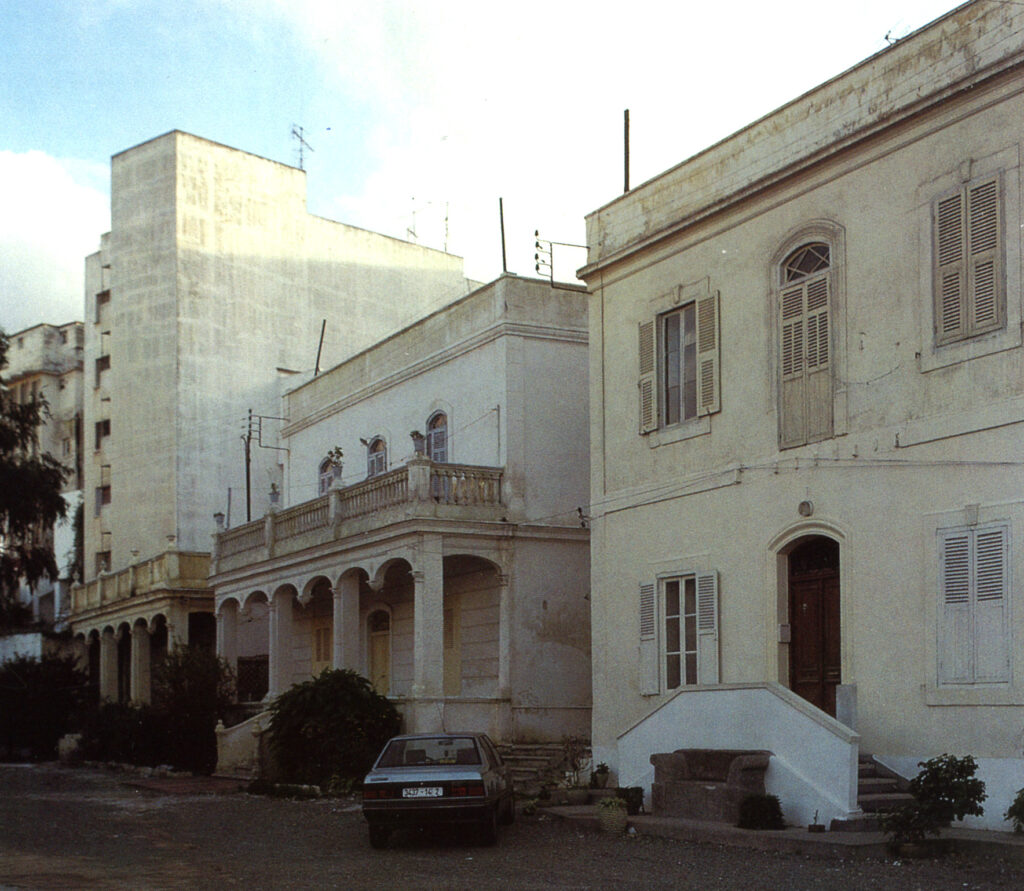
Moroccan and newly settled Jews became rapidly the main, if not the dominant landowners in the developing city. A map published around 1915 by the Comptoir Lorrain du Maroc owned by the Nathan brothers, who had arrived not long before from France, reveals the distribution of the properties they had acquired from previous Jewish owners.
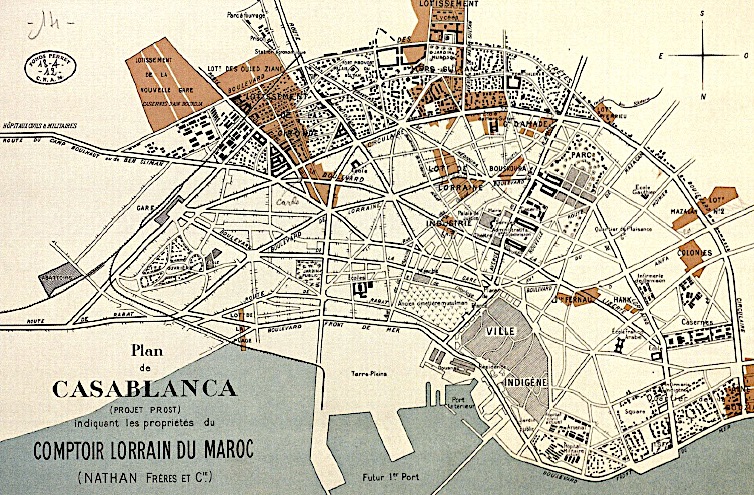
Besides the already mentioned minarets and the military barracks, the first buildings of the new town were the large Paris-Maroc department store, meant to ensure the presence of European trade, and a massive hotel, both erected in 1914 on the edge of the former Grand Socco market, which was transformed into a square. These two structures used the then experimental technology of reinforced concrete that had been pioneered, among others, by Auguste Perret, who designed the store.
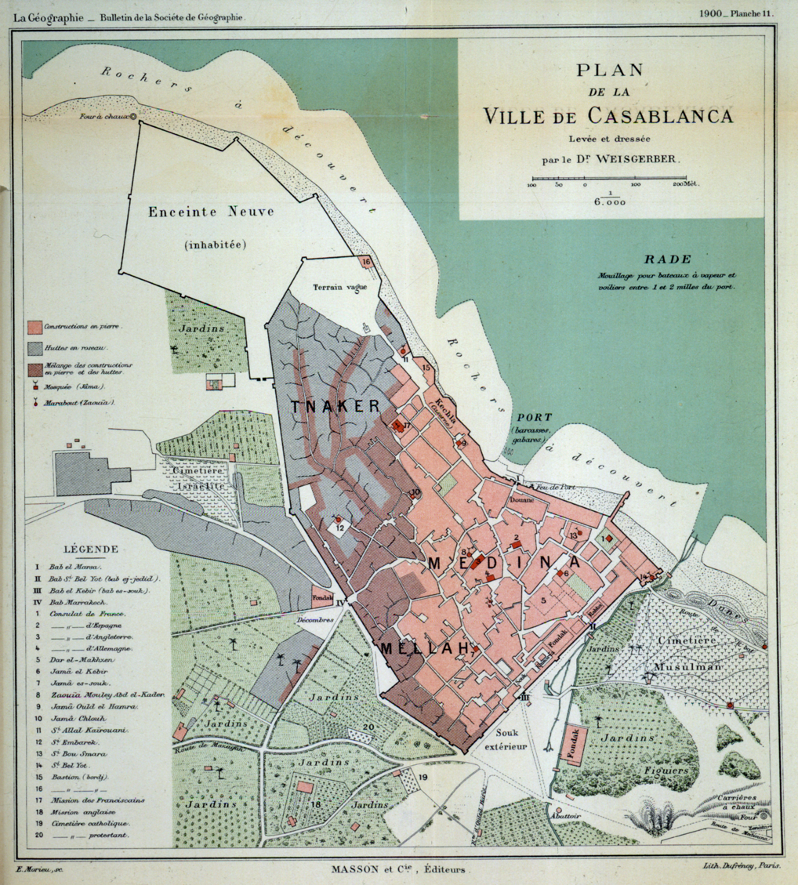
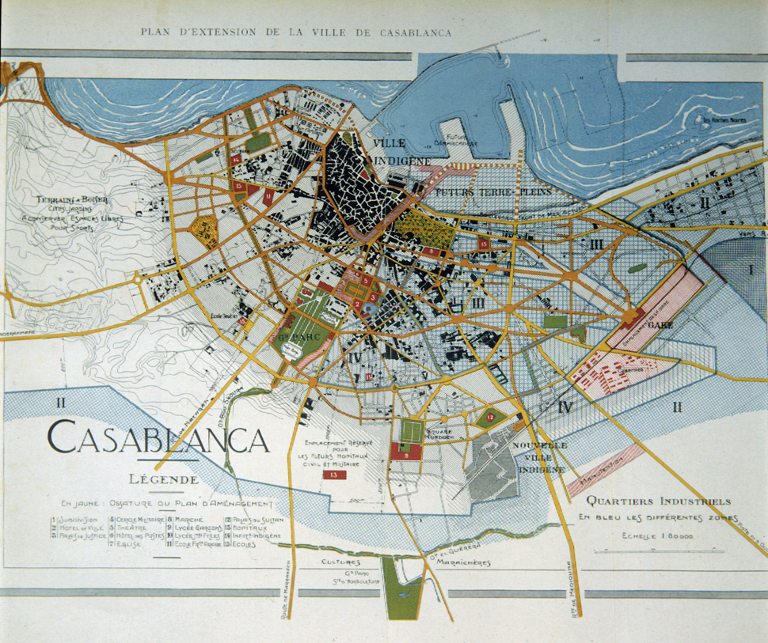
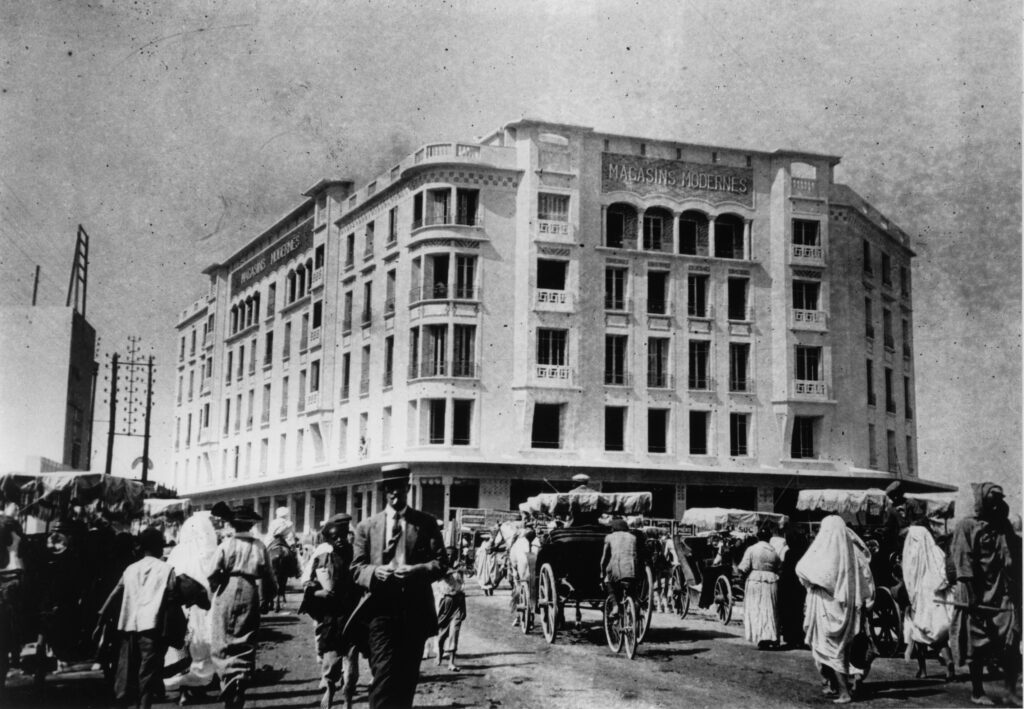
A locus of invention in building technology, Casablanca became the first city in the context of France and its empire in which the emerging discipline of city-planning was deployed, as a means of ensuring the long-term development of the city and curbing the selfish interests of private developers. Two figures joined their efforts in this attempt. The first was France’s Resident general in Morocco, General Lyautey, a forward-thinking officer, who was especially opposed to the brutal policies the French had implemented in Algeria with respect to existing cities. He was in favor of preserving historical Moroccan cities, and of implementing the latest planning techniques.14 To this end, he recruited Henri Prost, a young architect who had spent four years in Istanbul and had a feeling for the “Orient.” Prost was also an extremely able planner who knew German city planning well. Paradoxically, whereas the Germans had been expelled from Morocco, Prost conceived for Lyautey a functional zoning plan that divided Casablanca into different areas devoted to specialized functions, and defined the morphology of buildings, which was entirely based on the norms of Städtebau—the city planning discipline that had been conceptualized in Germany since the 1870s.15 Prost was also active in defining new urban spaces such as the large administrative square, which was an echo of the eighteenth century Place Stanislas in Nancy, dear to both Lyautey and Prost, who were from Lorraine. The translation of this model is an excellent example of what I call inter-urbanity—a term modeled on inter-textuality—by which I describe the borrowing of urban elements by one city from another one.16 The features of the public buildings lining the square echoed Moroccan historical architecture, combining traditional patterns of decoration with modern programs.
Approved in 1917, Prost’s plan was not implemented by breaking through the previous layers of the urban fabric with large thoroughfares like those of Haussmann in Paris, but by negotiating with the existing owners the creation of the new streets. Specific areas were delineated for the negotiation with the owners, probably half of whom were Jews. If for instance the Nathan brothers owned initially 20% of the land, after giving to the city the space necessary for the opening of the street they ended up with the same percentage of buildable lots. This process was efficient in creating a new city on a territory that had already been developed according to a messy, unplanned, pattern. In the end, Prost engineered a pragmatic new town by introducing a new structure which rearticulated existing urban developments. According to this method, the Lusitania Quarter in the southwest of the precolonial city, dotted haphazardly with new houses built by Jews who had left the Mellah, was reshaped with broadened streets, which created a pleasant atmosphere. Its plan was advertised as a model example in Edmond Joyant’s city-planning handbook of 1923.17
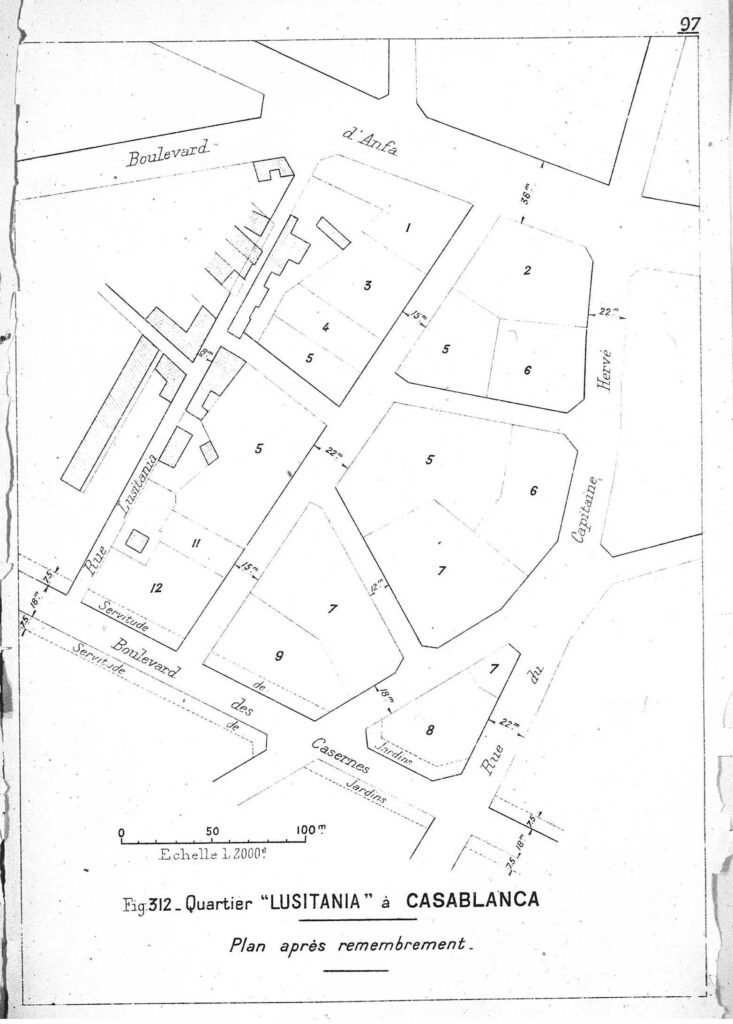
Conflicts between the Protectorate and the Jewish community also broke out, most notably in what was left of the Mellah, on the edge of the place de France, which had replaced the Grand Socco. Earmarked for demolition in the early 1920s, the surviving blocks were meant to be replaced by massive commercial and residential buildings. The authorities declared that this area was made up of filthy, insalubrious houses, dismissed in racist terms as being the “infect corner of the Mellah,” a sore spot in the middle of the gleaming new colonial city. Jewish families and religious authorities protested vehemently against the demolition of old synagogues and existing residences.18 In the end, demolition took place, but nothing got built, and the emptied land, which was only partially developed in the 1950s, has remained to this day a problematic entity in the city’s center.
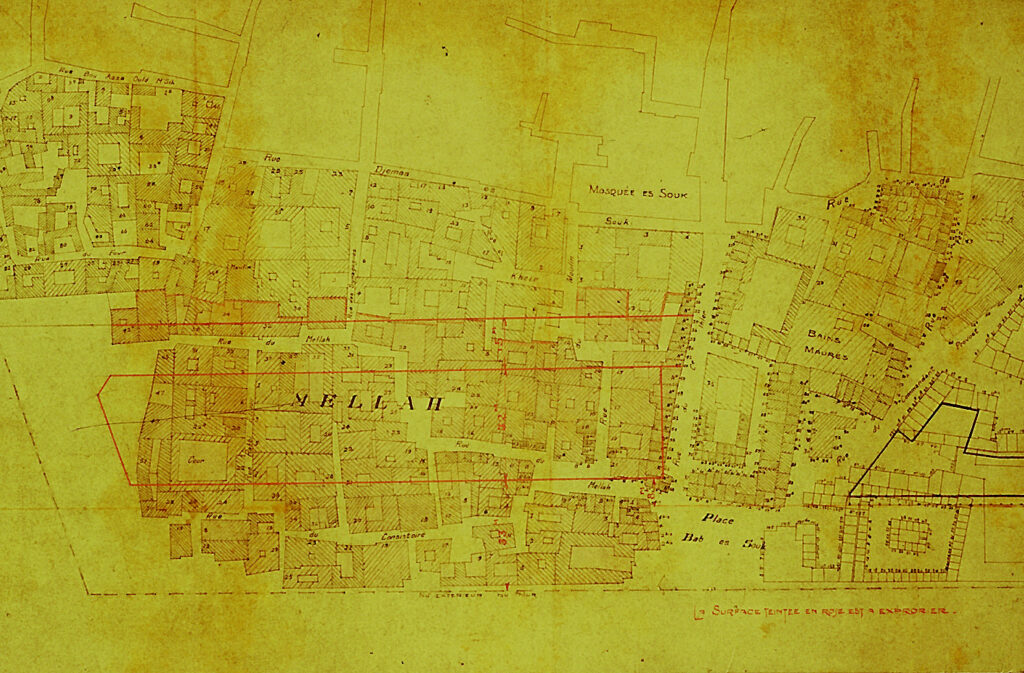
At the same time, Jews were excluded from the major developments undertaken by the Protectorate for Moroccans. Prost’s 1917 plan envisaged the creation of a “new indigenous town,” combined with a palace for the Sultan. Jews were initially supposed to be included in this new medina, but they eventually ignored it. Nonetheless, the project was made possible thanks to the prominent Jewish trader and financier Haim Bendahan, who gave the land to the Sultan. As this gift could not be accepted, the administration of religious foundations—the Habous—was put in charge of developing the land, which it still owns today. The streets, the squares, the markets and the houses were exquisitely designed between 1918 and 1922 by Albert Laprade, Edmond Brion and Auguste Cadet, who had studied in great detail the architecture of Andalusia and coastal Morocco.19
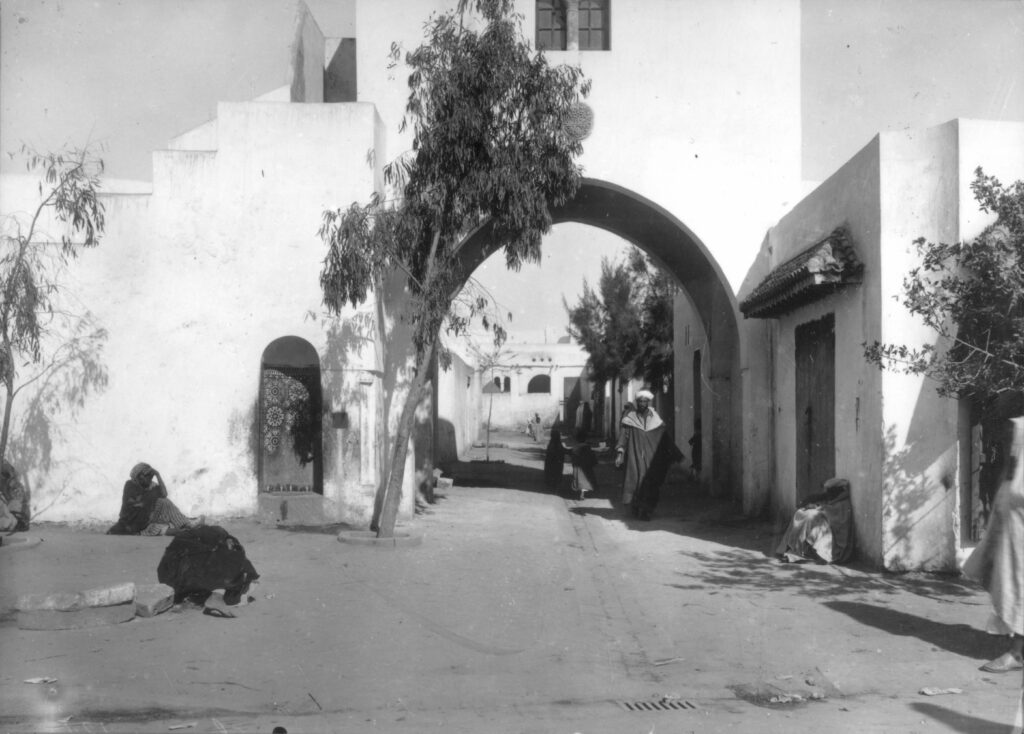
In the 1920s, Casablanca’s harbor expanded rapidly, after the diminutive facilities inherited from ancient Anfa had been discarded, becoming one of the most important of the continent. The city’s airfield quickly rose to be a hub in the new air connections with Africa and South America organized by the legendary Aéropostale and its pilots Antoine de Saint-Exupéry and Jean Mermoz. Correspondingly, the population grew exponentially, including its numerous Jewish contingent, who participated significantly to the building of the new town in their three roles of owners, builders and architects. Among these, the designers who came to Casablanca belonged to various groups. Many of them were war veterans, often without family connections or social capital in France, where they would not have made a big career. They found exceptional opportunities in Morocco, where the Jewish landowners were eager to commission significant programs for their businesses and residences.
They patronized architects of all origins, including Jewish professionals such as the Suraqui brothers, who belonged to a Gibraltar family which had moved to Algeria, where they had been trained not as architects but as surveyors—at that time no specific degree was required to practice in France and its Protectorates. Joseph was well—traveled and the frequent trips he made to Berlin in the 1920s explain the angular expressionist features of some of his buildings.
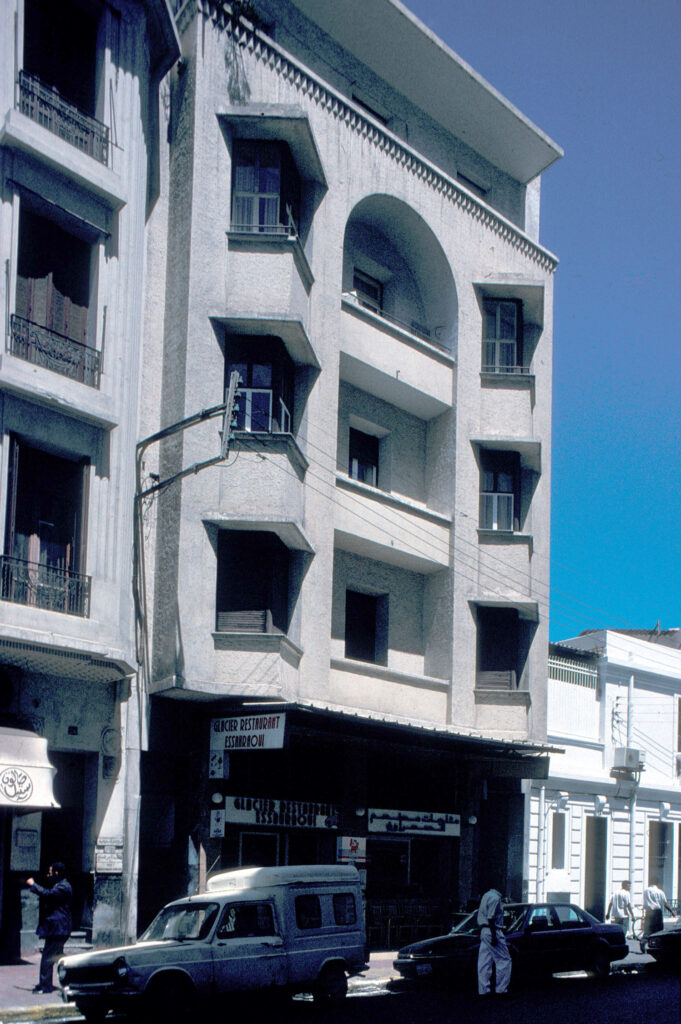
With his younger brother Elias, he built houses for Moroccan Jewish families such as the Benzaken, Coriat, Ettedgui or Tolédano, as well as for French Ashkenazi migrants who had arrived to develop industries and real estate deals, like the Braunschwig (1927). The clienteles were not rigidly segregated in the city, and the Suraquis also built apartment houses for contractors such as Gallinari and Meffre (1924 and 1929). Other programs were developed jointly by investors of different communities, as in the case of the Hassan and de la Salle building overlooking the square Louis Gentil, near the Paris-Maroc store (1928). Their architectural language covered a wide spectrum, from the eclectic use of historicist elements to the deployment of Art Deco ornaments, without any apparent correlation between the origin of the clients and the lexical elements used.
The new town was characterized by the cohabitation of diverse owners. The large block built by the Pertuzio brothers for the Great Vizir El Hadj Omar Tazi (1929), with its rather heavy Deco friezes, faced Brion’s sleek block for Haim Bendahan, one of the first examples of streamlined modern architecture, which resembles the upper decks of an ocean liner (1935). The nearby street rapidly took his name. During the interwar period, the tallest buildings of the new town were built by Jewish patrons, with few exceptions. I see in this skyward thrust nothing less than a revenge over the dhimma. Being able to build the highest structures reflected the new condition of a fully emancipated Jewish bourgeoisie. The main works of Marius Boyer, certainly the most original and prolific of all the architects active in Casablanca, bear witness to this policy. After having built a remarkable block with a shopping arcade for El Glaoui, the pasha of Marrakesh (1922), he planted a striking beacon on the boulevard de Marseille for Lévy and Bendayan, who had come to the city from Tangiers (1928). Operating like a gateway on one of the main arteries, the building has many hygienic features such as open courtyards, and extremely beautiful cylindrical staircases inside.
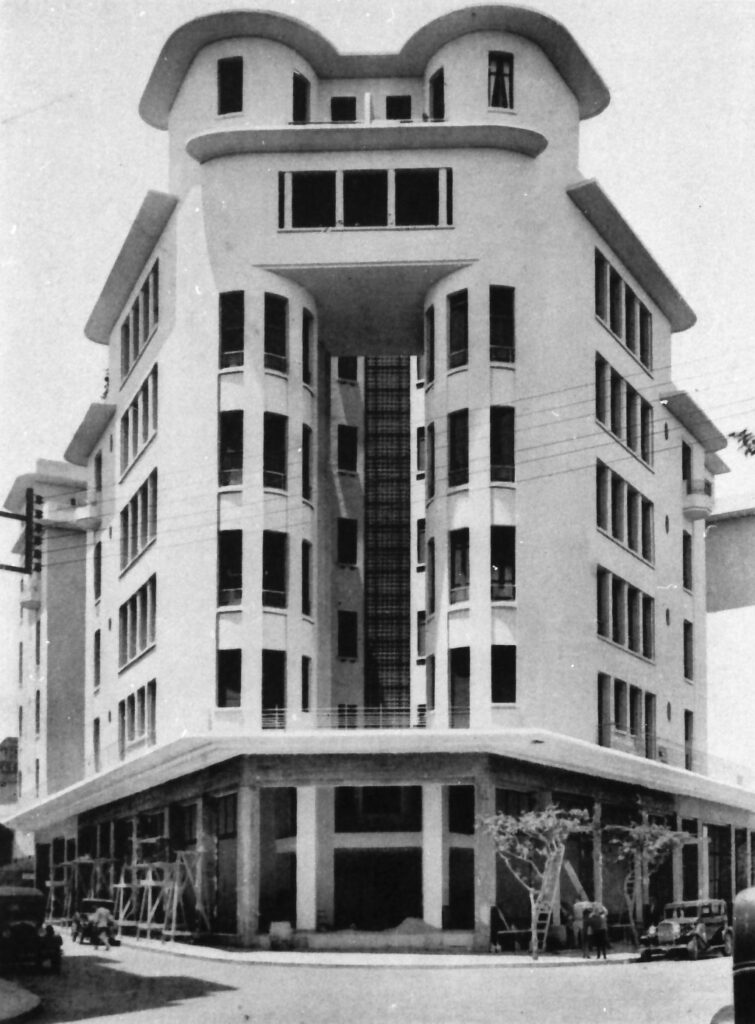
Even more daring is the Moses Asayag building, sponsored by another Jew from northern Morocco (1930-1932). With its ten floors, it would not have been tolerated in Paris at the time. The zoning provisions of Casablanca were way more permissive than in France. Its three imbricated towers carry superimposed set-back balconies, which could also be compared to those Henri Sauvage had been unable to build in Paris or those prescribed by the 1916 zoning ordinance in New York City. Around 1930, Boyer imagined a rather extravagant project for the vertical development of the city, with giant porticos which echoed Le Corbusier’s 1925 Voisin plan for Paris.20 This was exceedingly optimistic, even if Morocco, unlike France, escaped the Depression and saw construction continuing throughout the 1930s.
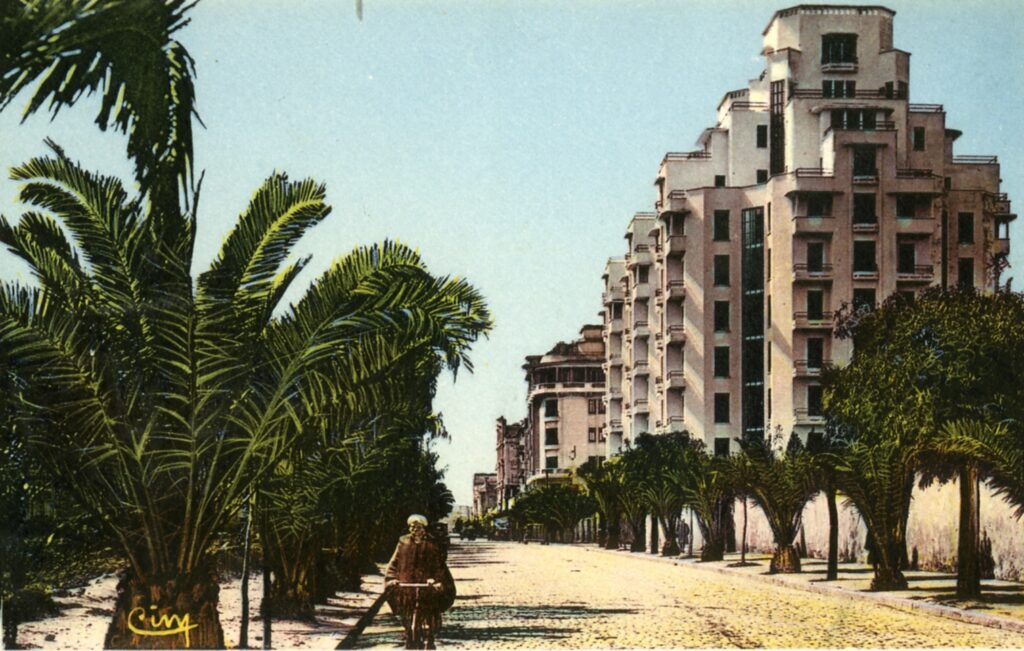
In the residential areas of the city, the single-family houses of the wealthier Jews were often deceptively simple on the outside and extravagantly over-decorated inside. Such was the case of the Assaban villa on boulevard de Bordeaux, whose architect we have been unable to identify, the municipal archive of building permits remaining of extremely difficult access.
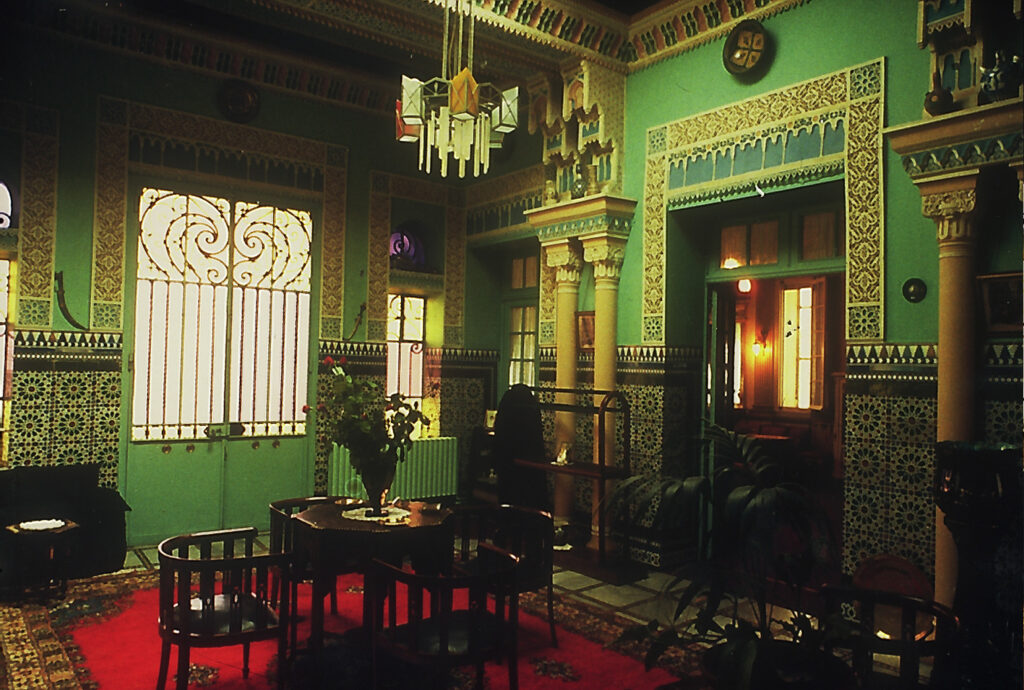
It is an eloquent example of the dual culture of its owners, with its gilded Louis XVI decorations adjacent to a Moroccan lounge combining Arab-Andalusian decoration and Viennese Sezession seats. On boulevard Moulay-Youssef the Suraquis built the more rigorous but no less luxurious villa Violetta, still standing with its remarkable ironwork and tilework, while the interior has been gutted nightly before demolition was interrupted. In these houses, refined construction techniques were used to build exquisite details, associating Moroccan maâlmin—master artisans—with Italian stonemasons and joiners. As for Boyer, he built for Asayag a rather conservative villa with a neo-Moroccan patio, apparently sticking for his own use to a tamer language than the one he accepted for his tenants. His villa for Raphaël Bénazéraf, sadly lost, which had nothing historicist or neo-Moroccan on the exterior, used abstract decoration inside, with a magnificent staircase lined with black marble and little golden tiles and a remarkable bedroom with Deco lights, and an adjacent bathroom clad in white marble.
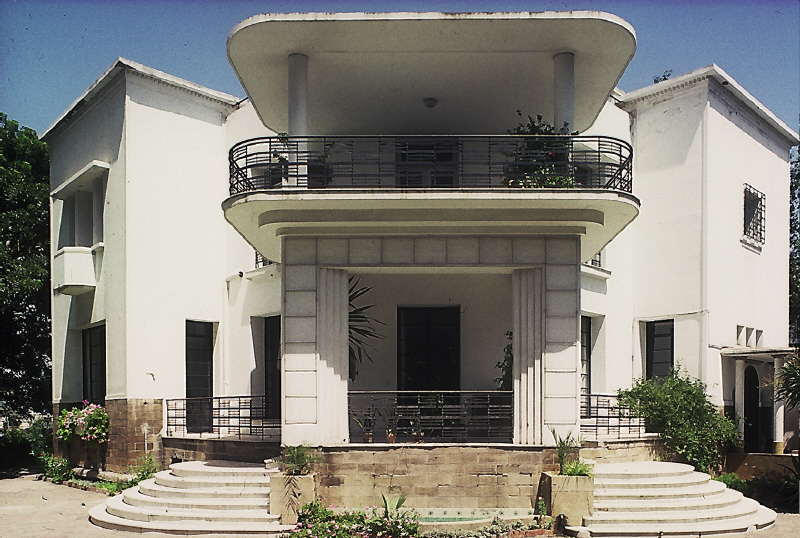
The Jewish community also had its own buildings. In the medina, the surveyor Georges Buan built an elegant synagogue. A more monumental structure was built by the Suraqui brothers for the school of the Alliance Israélite Universelle, which was active in Morocco, including Casablanca, since the 1860s and was supported by the Protectorate as a means of French penetration.21 Built on the beautiful palm-tree lined boulevard Moulay Youssef, the school used neo-Moroccan decorative elements and took the name of the former president of the Alliance Narcisse Leven, an active fighter against French anti-Semitism.
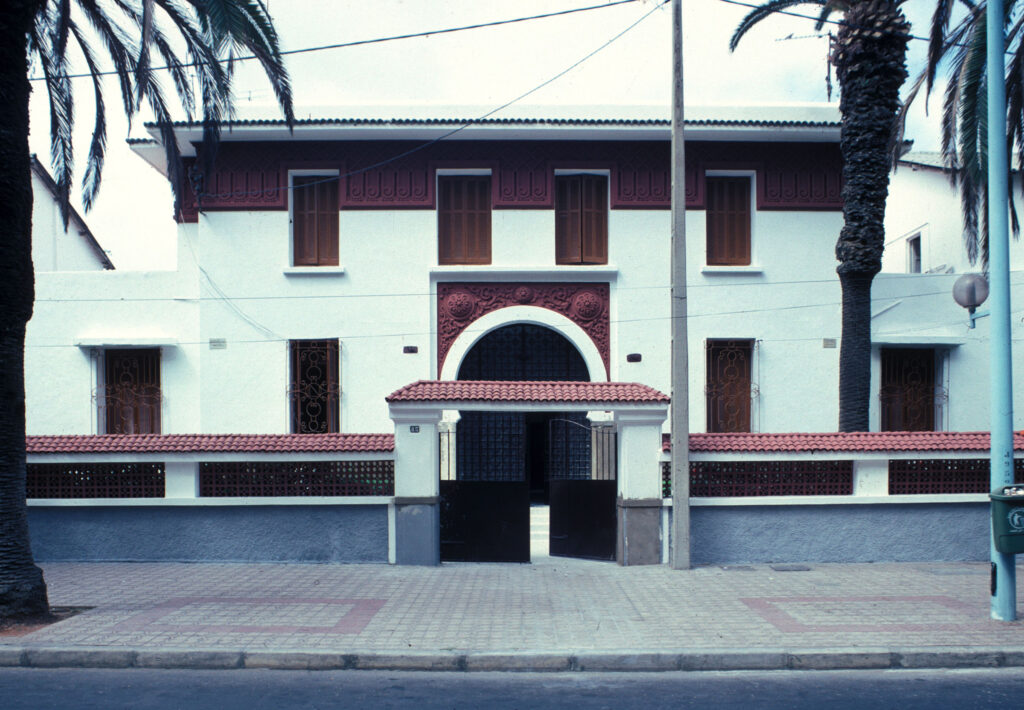
The demographic expansion of Casablanca continued throughout the 1920s, its population growing from 30,000 in 1907 to 160,000 in 1931, including 20,000 Moroccan Jews—the only ones identified as such. Jews of French—including Algerian—or other origins, were not counted in this figure. The growth was substantial also in the following years. In 1936, Casablanca reached 260,000 inhabitants, the population of Algiers or Bordeaux at the same time. The Moroccan Jewish population doubled during that period, under the eye of foreign observers. The contemporary reception of Casablanca’s urban development in the press of Mandate Palestine is eloquent:
Out of all the cities of the East, Casablanca is most modern. In the beauty and rapidity of its construction it resembles our Tel Aviv, its streets are wide and with avenues of trees and flowers. Its buildings are large and lavish with all the modern comforts. The city has grown thanks to the large modern seashore which was built after the war.22
The success of a city which was based on its gateway status, also meant that poor Muslims came in mass to the city from the Moroccan hinterland and started living in newly created shanties, which became proverbial in all the French empire under the name of bidonville. This “drum city” made of flattened metal oil containers, which occupied a territory located South of the Habous quarter, became the generic term for shanty towns in the French empire—Paris included—for decades to come.
During the Second World War, the Resident General of France Charles Noguès sided with Vichy and the Moroccan Protectorate implemented the racial laws passed by Pétain’s government. In 1941, Jews were prohibited from residing in the new town—with the exception of those inhabiting suburban villas—and had to resettle in the old medina in exceedingly insalubrious conditions. They were fired from civil service jobs and a numerus clausus was implemented in all the professions. I have not done the research needed to see how it applied to the architects who were Jewish, and if the limit of 2% of the “aryan” professionals was enforced, but since they were marginal in the architectural profession, it might not have been applied. Some Jews were detained by the Protectorate—this was the case of the Suraqui brothers—and the deportation of the Jews was prepared before the Allied landing of November 8, 1942. Legend has it that the Sultan of Morocco Mohammed V enacted measures to protect the Jews from increased prosecution. Historical evidence now seems to show that this was far from the truth and that the Sultan was not as protective as generally remembered.23 In any case, the Allies arrived at the right moment, just before brutal actions were going to be taken. Yet the Moroccan Jews’ loyalty to the country went very far in terms of celebrating both Mohammed V and his son Hassan II, who made money in the 1960s by selling them the passports they needed to emigrate to Israel.
The name of the city became familiar to the entire world, on the occasion of the conference the Allies organized in January 1943 in Anfa, the high-end residential area of the city resembling Beverly Hills. The meeting, during which the war goals of the Western powers were discussed , was marked by the rivalry between generals Henri Giraud and Charles de Gaulle. In parallel to the summit, Roosevelt had a conversation with Mohammed V, in which he promised Americans’ help in the Moroccans’ drive toward independence.24 Simultaneously, “Casablanca” became a worldwide brand thanks to the film shot in Hollywood by Michael Curtiz, which cast the city as a place of transit and intrigue between Europe and America, not paying much attention to the physical identity of the eponymous city. In fact, as I have found out in the Warner Brothers archives, envoys were sent to Casablanca to take photographs of the actual city. In preparing the production of the film, a scrapbook was compiled by the studios, documenting with press clippings and maps city streets, French uniforms, cafés, and vernacular costumes. Yet in the end, the film is essentially about love and only marginally about the city. Its success led to a series of imitations such as the Marx Brothers’ A Night in Casablanca, Gille Grangier’s modest Casablanca nid d’espions, or Bernard Borderie’s captivating movie La Môme vert-de-gris, with Eddie Constantine—released in the United States as Poison Ivy—all shot in Casablanca in the 1950s. The city’s celluloid fortune found echoes in literature and music throughout the 1940s and 1950s. In recent years, Moroccan filmmakers have put the city at the center of significant movies, such as Nabil Ayouch’s Ali Zaoua, enfant des rues (2000), Laïla Marrakchi’s Marock (2005) and Nour-Eddine Lakhmari’s Casanegra (2008).25
Between 1945 and the end of the Protectorate in 1956, Casablanca went through a new golden age, since it had suffered no destruction during the war. Capitals which had left France during and after the war fueled a renewed public and private building activity, in which Jews were heavily engaged, in particular in areas where villas were dominant. The most spectacular among these is the house of the ambitious, narcissistic developer Sami Suissa, built in 1947 by the extravagant architect Jean-François Zevaco, born in Casablanca in 1916. At the time nothing of that kind was happening in France, where reconstruction did not start until the early 1950s. Not far from the Suissa villa, the Schulmann villa was built in 1952 by Élie Azagury. A Jew from a Tangiers family, he was born in Casablanca two years after Zevaco, and in the same building—the Paris-Maroc department store and apartment house. Close friends, both Zevaco and Azagury were trained at the École des Beaux-Arts in Paris, since there was no school of architecture in Casablanca, which was then considered a city of business, sports and leisure, but not an intellectual capital like Algiers, where architecture was taught at the École des Beaux-Arts. The two young students spent the war years in Marseille, where an atelier had been opened for the refugees from Paris, and returned to Morocco after graduation, Azagury being the second Moroccan to get an architect’s degree. After working in Sweden and traveling to California, he brought back to Casablanca the architectural language Richard Neutra had explored in Los Angeles. The cantilevered sun-breakers of the Schulmann villa allude to the contemporary houses of Los Angeles, which found their best interpretation in the sumptuous villa built by Wolfgang Ewerth for the prominent Jewish cereal trader Maurice Varsano (1954).
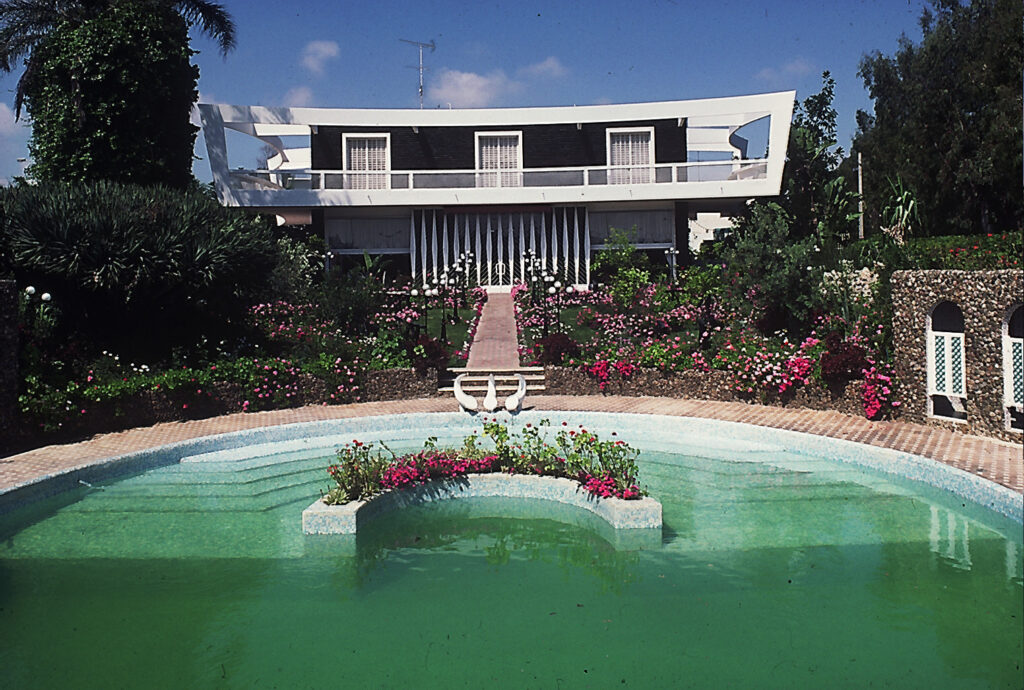
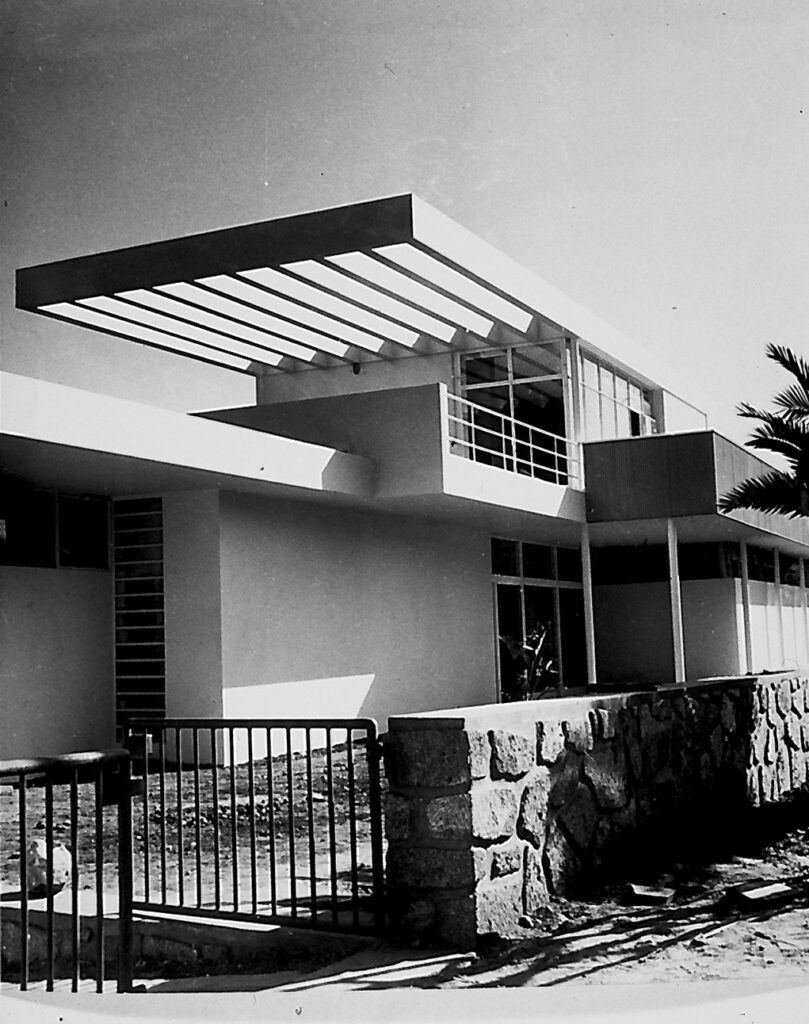
Critics had written that Casablanca, the “New York of a French California,” needed skyscrapers to enhance its flat terrain. This connection to California can also be perceived in the manner in which the most innovative villas of the late years of the Protectorate were advertised. The young photographer Marc Lacroix, who was briefed by Azagury to shoot villas in the style of the Los Angeles photographer Julius Shulman, the author of the iconic views of Richard Neutra’s houses, shaped the perception of the new villas.
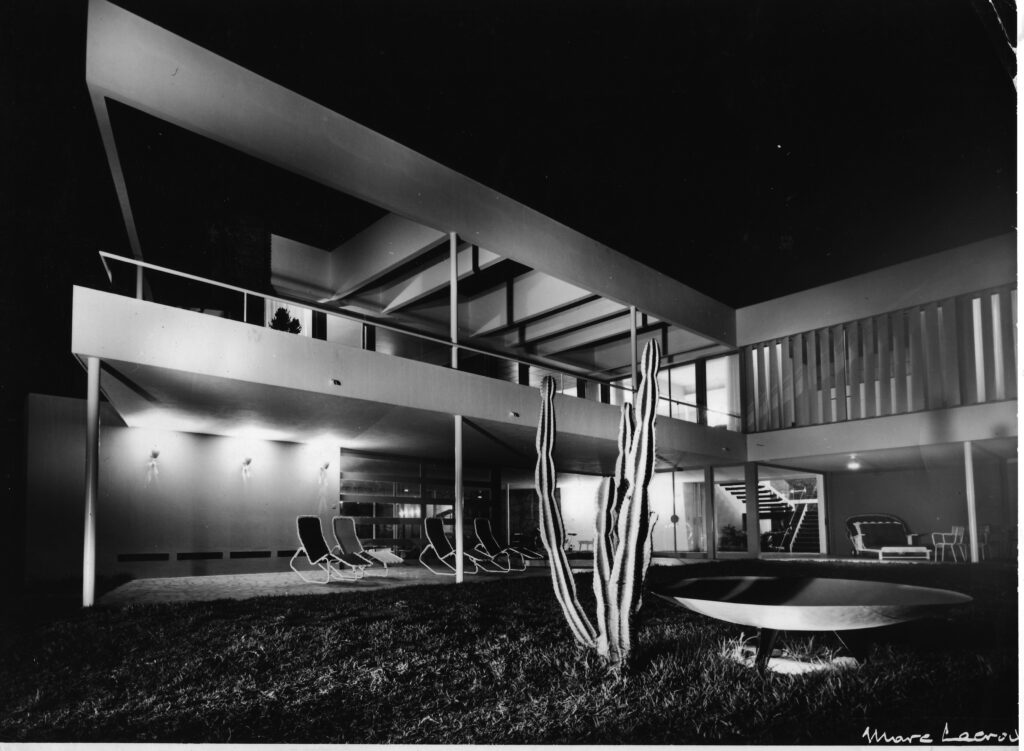
The context was favorable as, a few years after their landing in 1942, the Americans had returned when the Strategic Air Command created bases all over the country at the beginning of the Cold War. Casablanca was home to American airmen and their families, PX stores and other facilities. The streets were filled with American cars, and the homes with refrigerators larger than the French ones. Coca Cola was produced locally, whilst it was banned from French stores, after the sale of this “American poison” had been prohibited by parliament.26 Radio stations beamed out rock and roll music, an American atmosphere pervading a city where the everyday life had been until then infused by Spanish mores.27
At the same time, the Jewish presence had never been more massive, reaching 75,000 residents, that is one tenth of the total, around 1952. In 1960, 45 % of the entire Jewish population of Morocco lived in Casablanca. Modest single-family houses were built by the hundreds in the periphery, including many by the Suraqui brothers, who had resumed their production and also designed modern apartment houses. Jewish Moroccan professionals were able to patronize conspicuous programs, such as the sculptural building of the physician Gaston Brami (1952). Designed by Gaston Jaubert, a close friend of Azagury, its Brazilian allure was caught in Lacroix’ photographs.
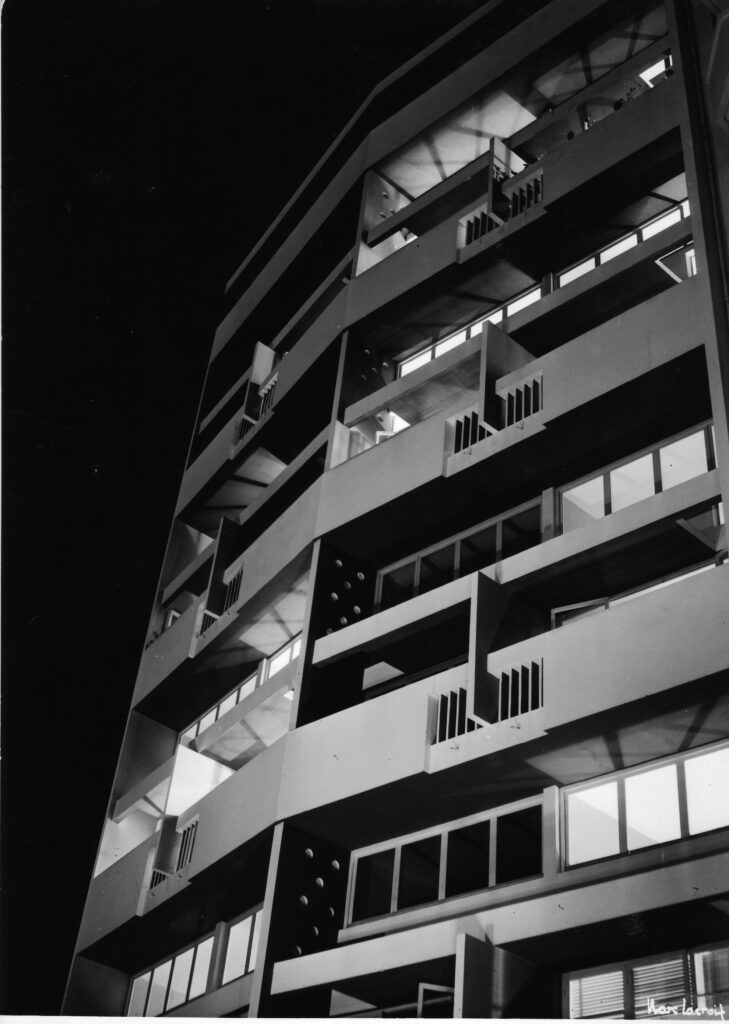
Brami was active as a doctor among the poor of the former Mellah, which had become an extremely dense and insalubrious area following the rules enacted by the Vichy Regime to eliminate the Jewish presence in the European town.28 After 1945, Jews resumed their immigration from the coastal cities and the interior of the country into Casablanca. In the late 1950s, before the decisive wave of emigration to Israel, the city housed half the Jewish population of entire Morocco.
For the first time, the expiring Protectorate tackled this pressing demographic challenge, thanks to the new plan for the expansion of the city drawn up in 1952 by Michel Écochard, previously active in Beirut, and a staunch supporter of Le Corbusier’s functional city. While the area of the municipality of Casablanca was tripled with respect to its prewar size, massive manufacturing facilities were planned along the coastline, in response to the resident general Eirik Labonne’s program for the industrialization of Morocco. Provisions were made for the accommodation of Muslim factory workers, a new fabric of low-rise courtyard houses replacing the expansive shanties, within which former assistants of Le Corbusier, such as Georges Candilis, erected acclaimed multi-family structures.
A parallel attempt was made by the administration and Écochard’s team to house the Jewish poor who continued to gather in the old town, with the creation of the Habitat israélite. Symmetrically to the Muslim housing schemes in the East, vast areas were earmarked on the Western part of the seashore. Damp and vulnerable to cold winds in the winter, these empty lots were deemed unfit for middle-class residences. Various attempts were made to imagine relevant housing types, beginning with slab buildings comparable to those used then in France. The first of these, built in 1950 by Louis Zéligson, a Jewish architect born in Baku, was rather close to European standards. It has stood alone to this day. A more ambitions scheme was built the following year by Zéligson together with Léon Aroutcheff, Raymond Lucaud, Léonard Morandi and Marcel Rousseau, its eight slabs distributed by open-air corridors functioning as windbreakers to protect from the ocean’s spray the areas in back, where Joseph Suraqui built a school run by the Alliance Israélite (1955). In the same neighborhood, designed for all the classes of the Jewish population, the veteran architect also completed on rue La Bruyère a long slab combining autonomous buildings ventilated by concrete screens, which are part of the dominant idiom in Casablanca, and two blocks for wealthier families (1954).
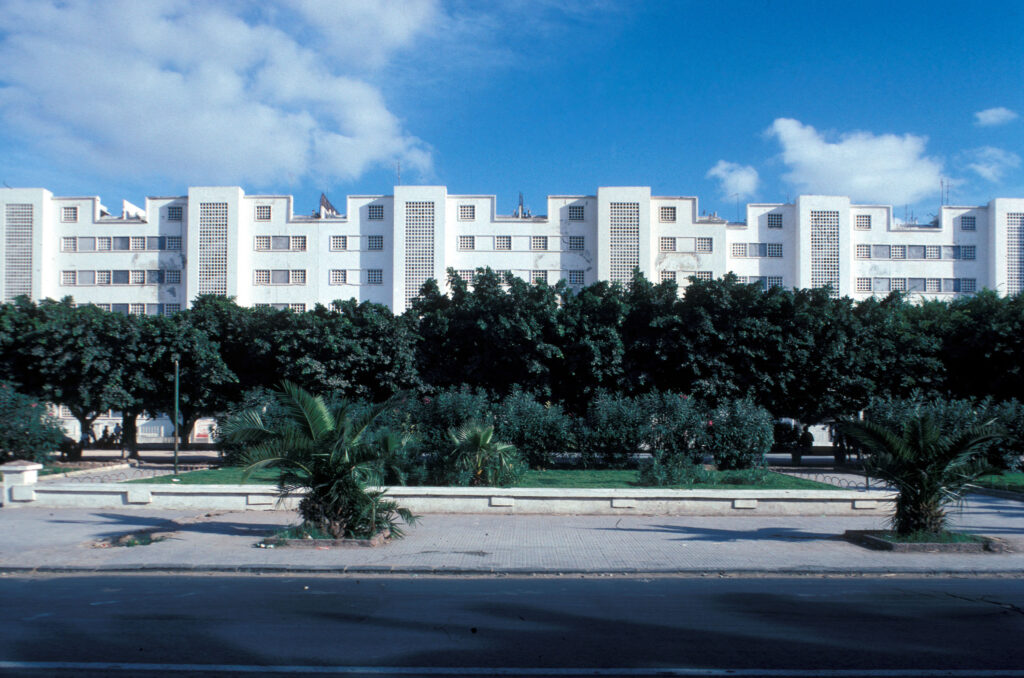
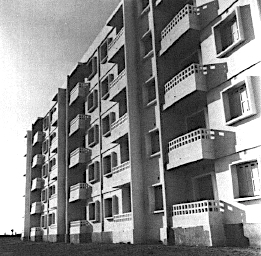
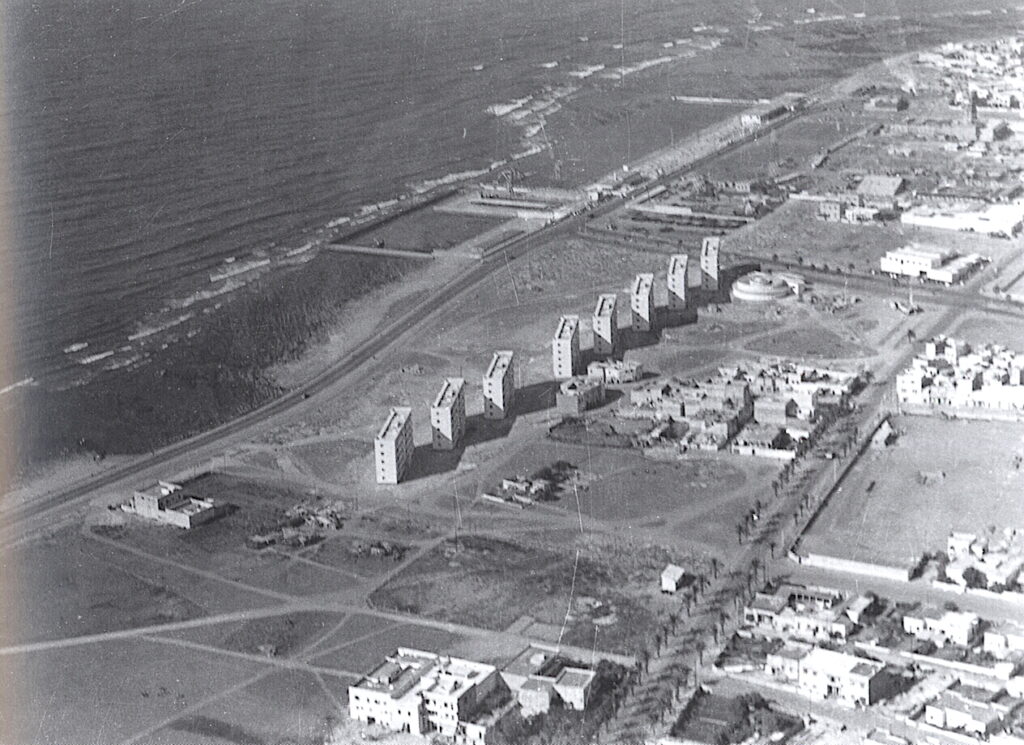
These programs did not exhaust the reflection on what Jewish housing was specifically meant to be. It had to be more open than the tightly enclosed Moslem dwellings, a requirement which found a remarkable interpretation in the brightly colored scheme of Candilis—a tridimensional interpretation of Piet Mondrian’s paintings. Jews did not require such a protection from the external gaze. According to the literature of the time, much attention was given to the issue of keeping menstruating women in seclusion, and to the provision of minimal versions of ritual baths. The ATBAT-Afrique team led by Candilis and Shadrach Woods designed specific apartments for Jews, which were more open, had no patios, and were more comfortable than the Muslim ones. In contrast to the zoning policy of the Protectorate, which segregated the housing estates meant for low-income Europeans, Muslims and Jews from each other and from the residential areas of the ruling class, ATBAT-Afrique went as far as combining in ethnically mixed buildings dwellings for each group. In this unbuilt project, the glazed façades of the European flats would have contrasted with the enclosed patios meant for Muslims and the intermediate volumes intended for Jews.29
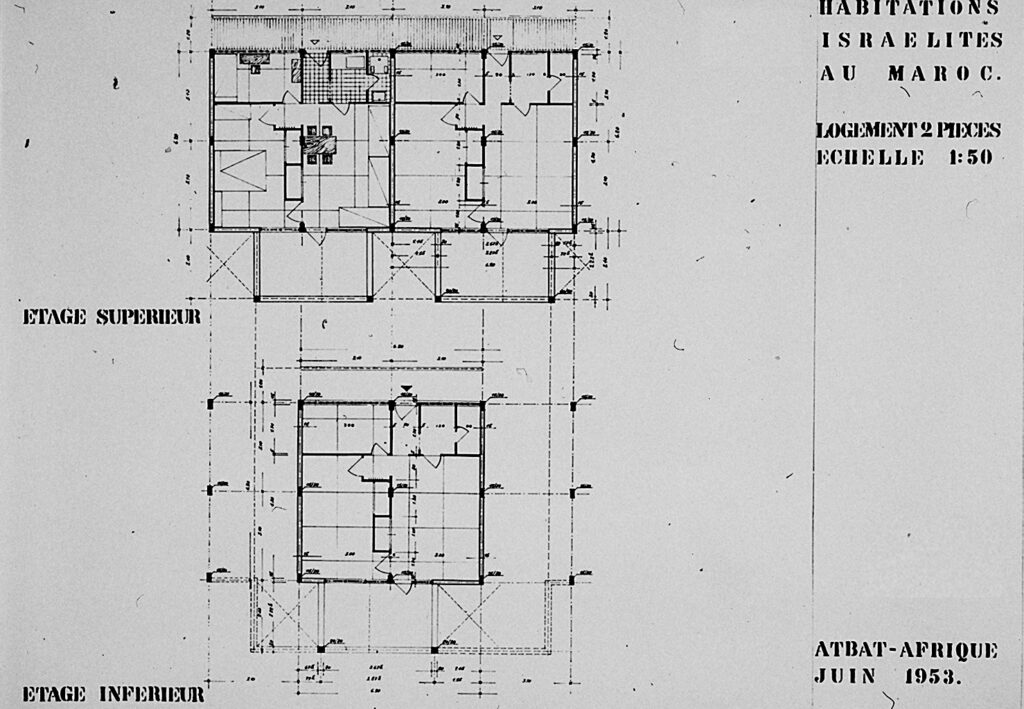
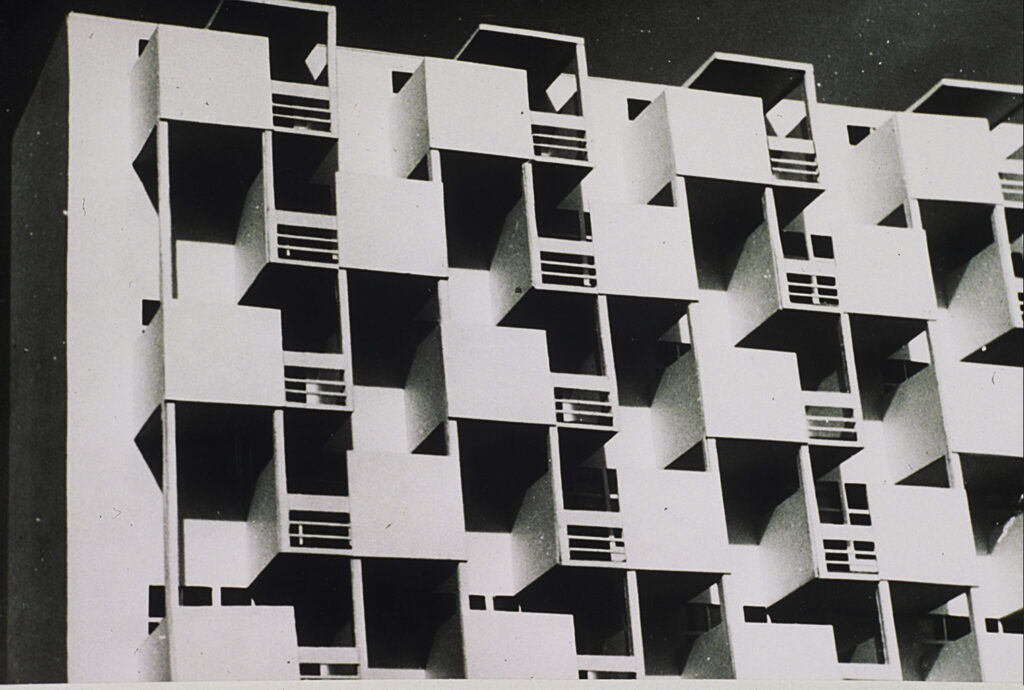
Zionist organizations started to promote/arrange emigration to Israel among the poorest Jews who had settled in Casablanca already in the late 1940s, but a significant proportion of the population remained until the aftermath of Independence, regained in 1956, and in some cases until 1967. Some Jewish professionals such as Azagury, a leftist who was viscerally attached to his country, not only remained, but also played an important role in postcolonial policies. He became the first president of the Moroccan Order of Architects after Independence and for more than fifteen years.
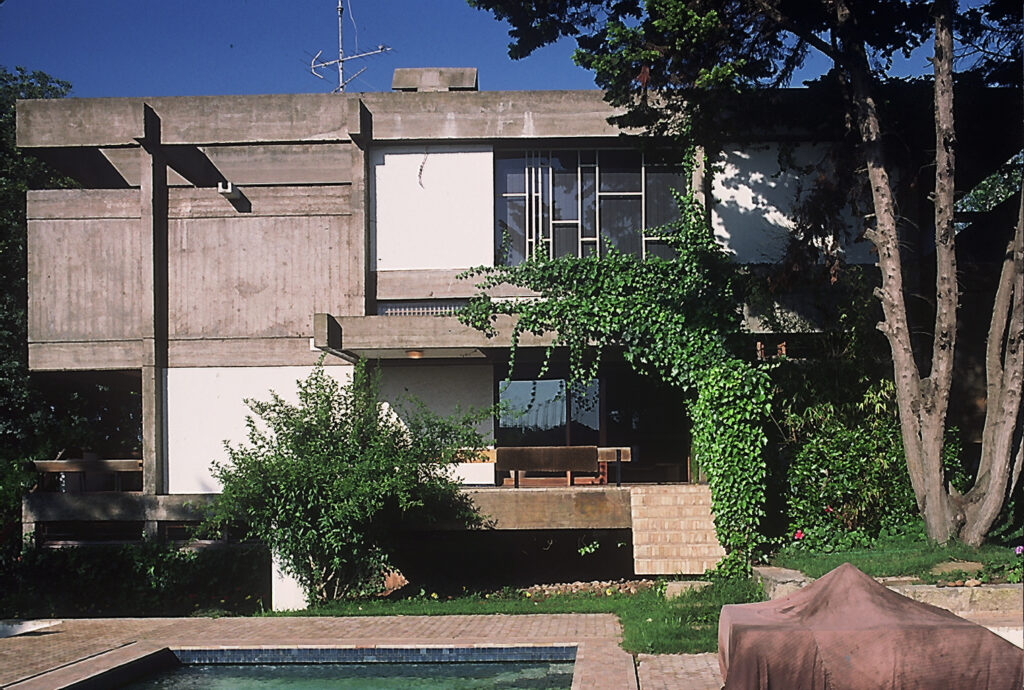
He was the main designer of the first housing scheme built by the new Morocco, in order to replace the Derb Jdid shanty. Now called Hay Hassani, and meant for low-income residents, the neighborhood recycled many of Écochard’s ideas, with an increased density. Azagury also built a large tea packing factory in the East of Casablanca (1958), two schools for the French missions (1963) and a gave a skillful interpretation of Le Corbusier’s brutalism with his own house (1962). After the 1960 earthquake, he took part in the reconstruction of Agadir, a collective effort which defined the country’s architecture for two decades.
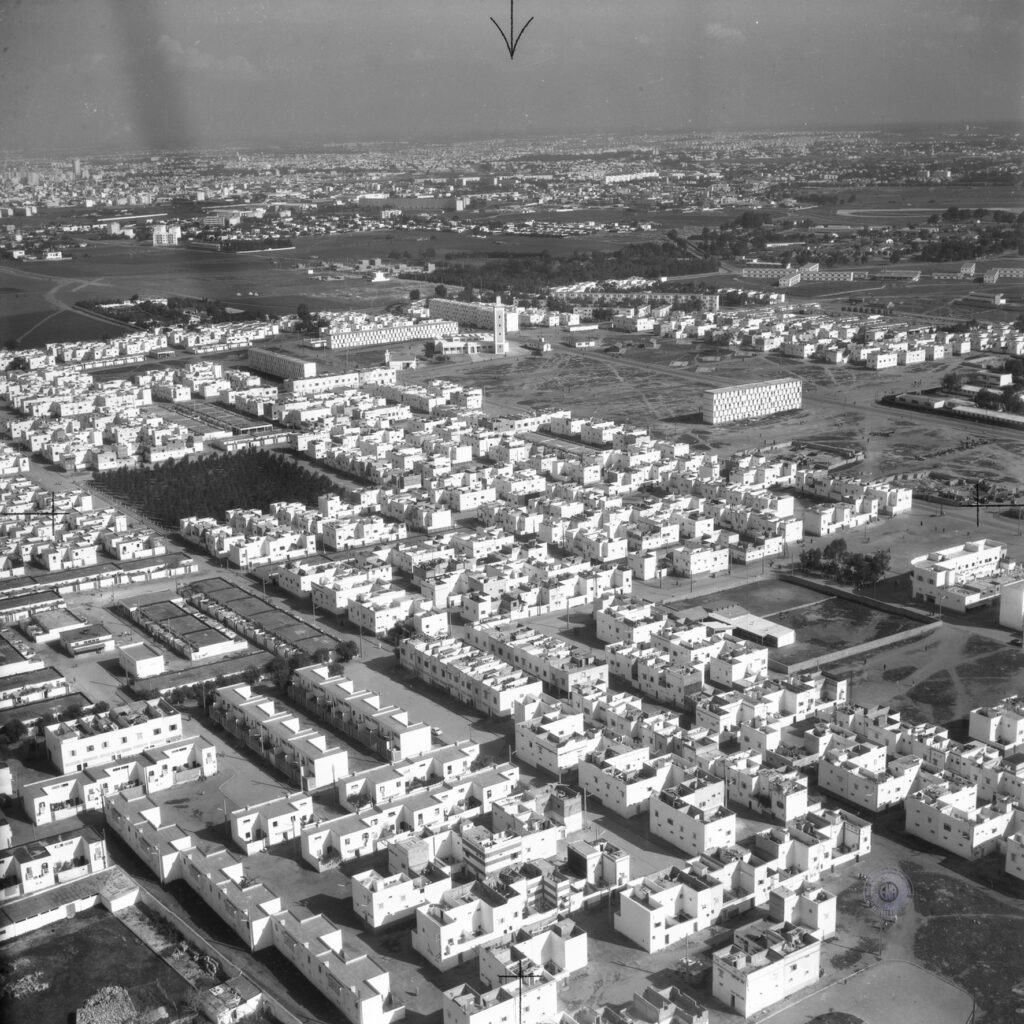
At a distance of more than fifty years, Casablanca’s Jewish population has shrunk to a few hundred families, but its properties still dot the city. The greatest number left for good and never looked back.30 But the wealthiest Jews, those who had mines and industries, kept most of their land, even if they had to “Moroccanize” part of it. Along the streets, abandoned enclaves are easy to locate thanks to the green mass of their overgrown vegetation, untrimmed since the 1960s.
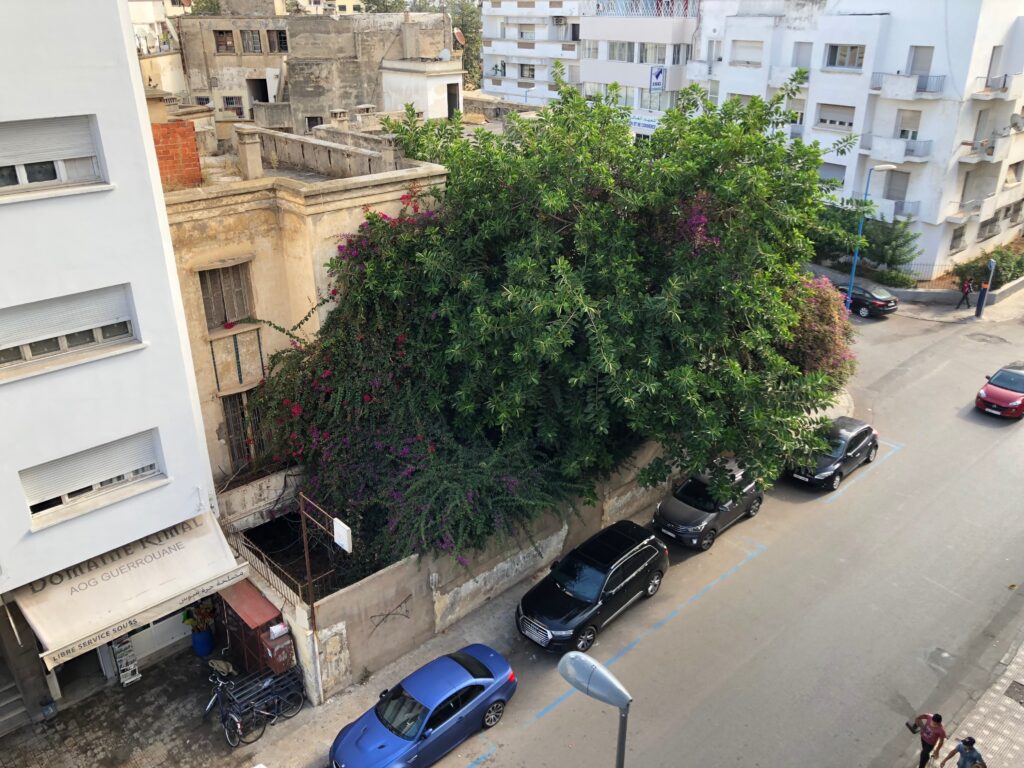
Among restored buildings, one finds the Ettedgui synagogue in the old town, and the Suraquis’ former Tolédano house, transformed into the Villa des Arts, an exhibition center operated by the ONA, the company that manages the assets of the king of Morocco. More significantly, the architect Aimé Kakon has reconfigured a former orphanage in order to house the Musée du judaïsme marocain created in 1997 by Simon Lévy. Its collections document Jewish everyday life and religious practice in precolonial and colonial times.
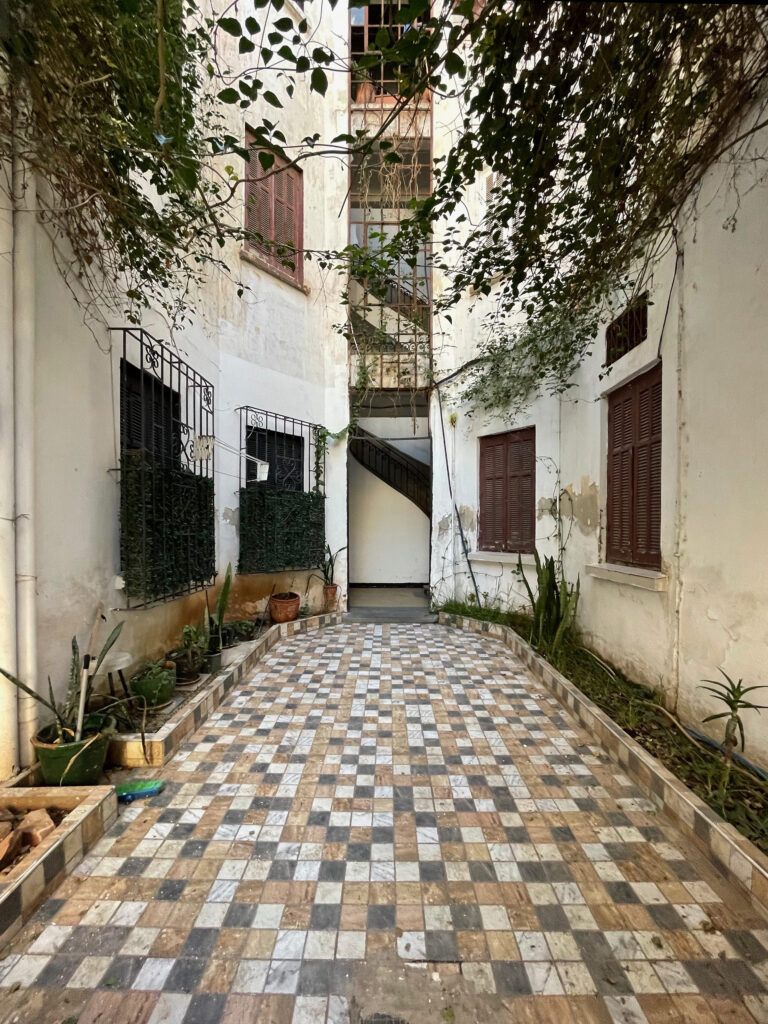
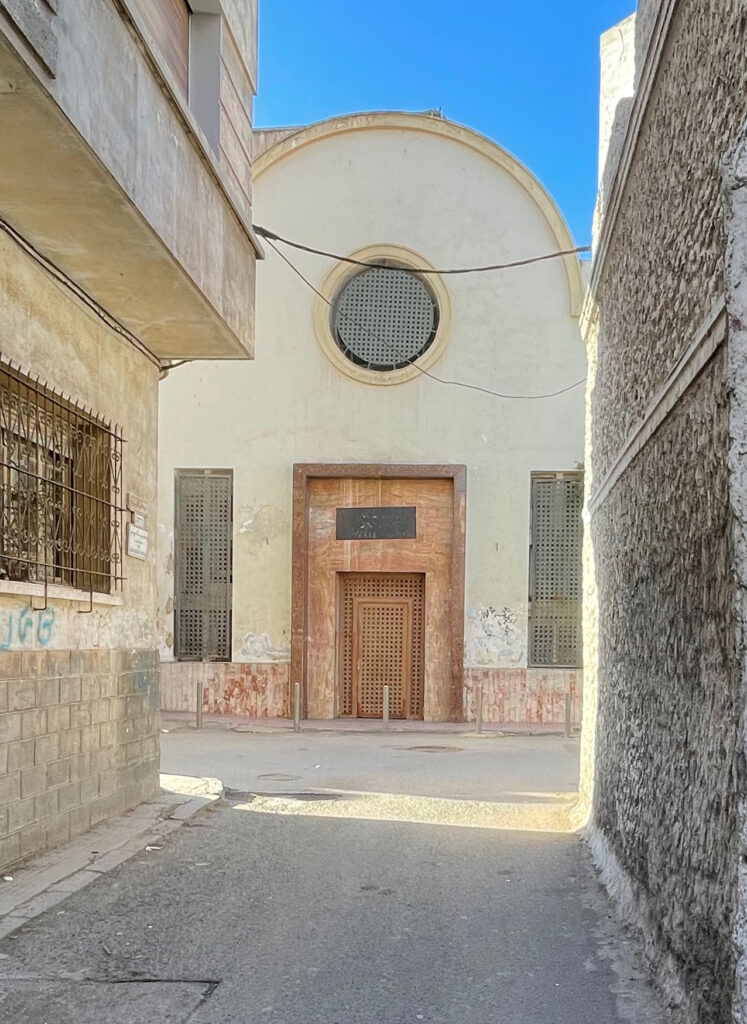
More than fifteen years after the publication of the book mentioned above, I have been drafted in 2017 into a deliberate endeavor to preserve the city’s heritage at large, including its Jewish component. A team of Moroccan and French architects and historians has established a plan for the conservation of the central city. When implemented in 2021, it will lead to the preservation of one fifth of the ten thousand buildings existing within the circular boulevard, focusing not only on the most spectacular ones, but including also vernacular enclaves, such as for instance the Lusitania quarter. Entire areas will be shielded from excessive and mutilating development, interior features such as the staircases or the lobbies being protected as well of course as the façades. In addition to this plan, which includes major structures related to Jewish patronage, such as the main buildings by Boyer, and others designed by the Suraquis, Azagury and others, objects scattered over the larger area of metropolitan Casablanca have been earmarked for preservation, including housing estates, villas and public buildings. In a city where half of Morocco’s gross national product is generated, the temptation to get rid of embarrassing historical evidence is always intense, but could be countered by the new rules.
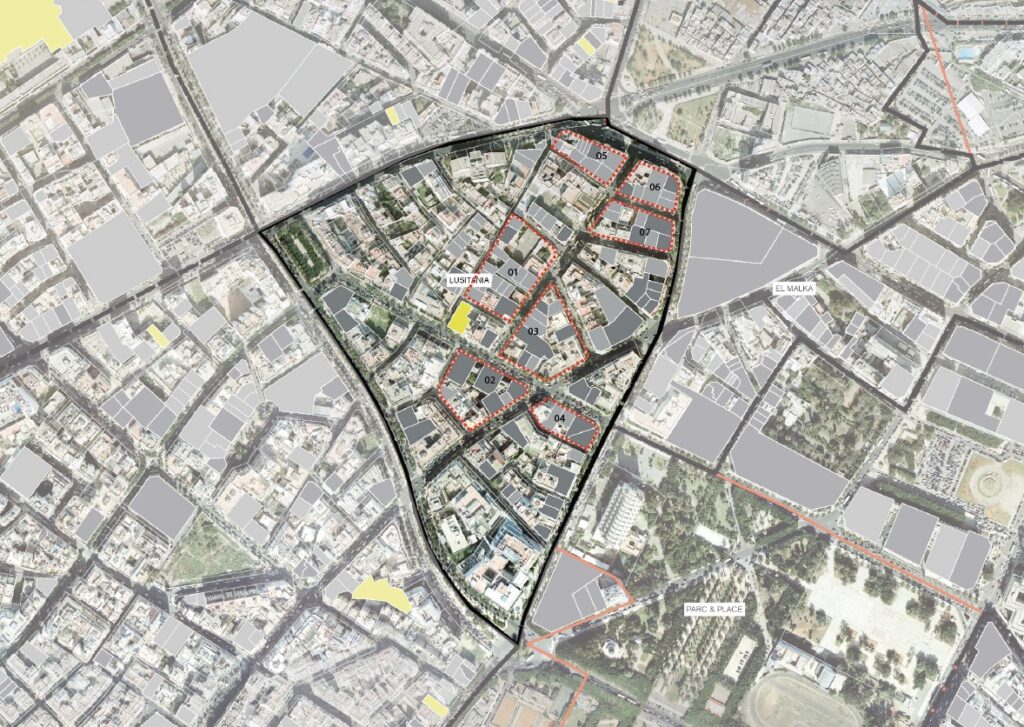
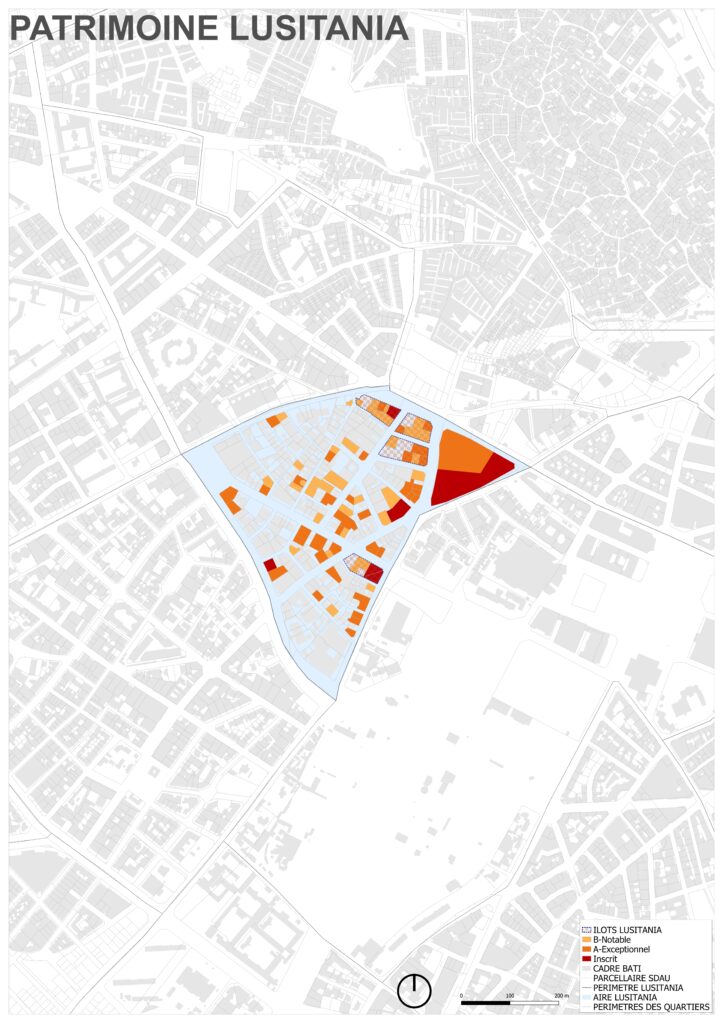
These recent developments have been made possible by the encounter of scholarly research such as mine and civil society, mobilized by non-governmental organizations such as Casamémoire, created in 1995 in response to the destruction of significant modern structures.31 They provide a sound foundation for a possible application by the Moroccan government to put Casablanca on the UNESCO World Heritage list. The declaration that a city born out of colonization and built by the combined genius of Muslims, Jews, and many others, has, according to UNESCO’s criteria, an “exceptional universal cultural value” would be a most significant move, and would respond to the immense love today’s inhabitants of Casablanca and all members of its diaspora, beginning with Jews, feel for the white city.
[1] Jean-Louis Cohen and Monique Eleb, Casablanca, mythes et figures d’une aventure urbaine (Paris: Hazan, 1998), new edition 2019. In English: Casablanca, Colonial Myths and Architectural Ventures (New York: The Monacelli Press, 2002).
[2] Marcel Cohen, Le parler arabe des Juifs d’Alger (Paris: Honoré Champion, 1912).
[3] Among the very few theoretically grounded analyses of the Protectorate’s planning policies was Paul Rabinow’s French Modern: Norms and Forms of the Social Environment (Cambridge, MA: MIT Press, 1989). Particularly the chapter “Techno-Cosmopolitanism: Governing Morocco,” 277-318.
[4] Jonathan Wyrtzen, Making Morocco: Colonial Intervention and the Politics of Identity (Ithaca: Cornell University Press, 2018).
[5] André Adam, Casablanca, essai sur la transformation de la société marocaine au contact de l’Occident (Paris: Éditions du CNRS, 1968).
[6] Georg Braun and Franz Hogenberg, Civitates orbis terrarium (Cologne: Bertram Buchholtz, 1572), vol. 1.
[7] On other Moroccan cities, see the fundamental contributions of Susan Gilson Miller: Susan Gilson Miller, Mauro Bertagnin, and Attilio Petruccioli, “Inscribing Minority Space in the Islamic City: The Jewish Quarter of Fez (1438-1912),” Journal of the Society of Architectural Historians 60, no. 3 (September 2001): 310-327. Susan Gilson Miller, “Apportioning Sacred Space in a Moroccan City: The Case of Tangier, 1860-1912,” City & Society (June 2001): 57-83.
[8] Map inserted in Dr. Félix Weisgerber, Trois mois de campagne au Maroc, étude géographique de la région parcourue (Paris: Ernest Leroux, 1904).
[9] Leland Louis Bowie and Gifford B. Doxsee, The Impact of the Protégé System in Morocco, 1880-1912 (Athens, OH: Centre for International Studies, 1970).
[10] André Chouraqui, La condition juridique de l’Israélite marocain (Paris: Presse du livre français, 1950). Doris Bensimon-Donath, Évolution du judaïsme marocain sous le Protectorat français, 1912-1956 (Paris/The Hague: Mouton et Cie, 1968).
[11] Reginald Rankin, In Morocco with General d’Amade (London: Longmans, Green and Co., 1908), 225.
[12] On the ordeal of Casablanca’s Germans, see: Gustav Fock, Wir Marokko-Deutschen in der Gewalt der Franzosen (Berlin and Vienna: Ullstein, 1916). Edmund Nehrkorn, Die Hölle von Casablanca: Erlebnisse eines Marokkodeutschen (Bern: Ferd. Wyss Verlag, 1918).
[13] Jean Hess, Israël au Maroc (Paris: J. Bosc & Cie, 1907). On Casablanca’s Jews, see David Cohen, “Le processus d’occidentalisation de la communauté juive de Casablanca (1890-1940),” in Les relations intercommunautaires juives en méditerranée occidentale. XIIIe-XXe siècles, ed. Institut d’études africaines (Paris: CNRS Éditions, 1984), 141-153. Yaron Tsur, Hagar Hillel. Yehude Kazablankah: ‘iyunim be-modernizatsyah shel hanhagah Yehudit bi-tefutsah kolonyalit (Ramat Aviv, Tel Aviv: ha-Universitah ha-Petuhah, 1995).
[14] Gwendolyn Wright, The Politics of Design in French Colonial Urbanism (Chicago: The University of Chicago Press, 1991).
[15] Jean-Louis Cohen, “Le plan d’Henri Prost, ou quand l’art urbain devient urbanisme,” in 100 ans d’urbanisme à Casablanca 1914-2014, ed. Abderrafih Lahbabi (Casablanca: École d’architecture de Casablanca, 2015), 30-43.
[16] See my exploration of this issue in Jean-Louis Cohen, “Frottage City,” Matières no. 16 (2020): 60-79.
[17] Edmond Joyant, Traité d’urbanisme (Paris: Eyrolles, 1923), fig. 311 and 312.
[18] Petition of some one thousand families to General Lyautey, December 26, 1921. National Archives of Morocco, Rabat, SGP, Études législatives, Plans de ville, Casablanca, 1926-1927.
[19] Gislhaine MeffreandBernard Delgado, Quartier Habous à Casablanca, une nouvelle médina dans la métropole (Casablanca: La Croisée des Chemins, 2018).
[20] The only monograph on this prolific designer is Marius Boyer, Casablanca, travaux d’architecture (Strasbourg: Edari, 1933).
[21] Michael M. Laskier, The Alliance Israélite Universelle and the Jewish Communities of Morocco: 1862-1962 (Albany: State University of New York Press, 1983).
[22] Ezra Shmualy, “The Jews in the French Colonies of North Africa,” HaOlam [Tel Aviv] (April 1936), 31.
[23] On this controversial issue, see Michel Abitbol, Les Juifs d’Afrique du Nord sous Vichy (Paris: Maisonneuve et Larose, 1983); Georges Bensoussan, Juifs en pays arabes : Le grand déracinement 1850-1975 (Paris: Tallandier, 2012); Aomar Boum and Sarah Abrevaya Stein, eds., The Holocaust and North Africa (Stanford: Stanford University Press, 2018).
[24] William A. Hoisington, The Casablanca Connection, French Colonial Policy, 1936-1943 (Chapel Hill: The University of North Carolina Press, 1984).
[25] On the visual production relative to the city, see Susan Ossman, Picturing Casablanca: Portraits of Power in a Modern City (Berkeley: University of California Press, 1994).
[26] Richard F. Kuysel, Seducing the French: The Dilemma of Americanization (Berkeley, Los Angeles: University of California Press, 1993), 52-69.
[27] On the Spanish legacy and presence, see Eric Calderwood, Colonial Al-Andalus: Spain and the Making of Modern Moroccan Culture (Cambridge, MA: Harvard University Press, 2018).
[28] Gaston Brami, Les Contes de mon Mellah, ou les tribulations d’un médecin débutant à travers un ghetto insolite (Place of publication unknown, 2002).
[29] Monique Eleb, “An Alternative to Functionalist Universalism: Ecochard, Candilis and ATBAT-Afrique,” in Anxious Modernisms, Experimentation in Postwar Architectural Culture, eds. Sarah Williams Goldhagen and Réjean Legault (Cambridge, Mass.: MIT Press, 2000), 55-73. Tom Avermaete, Another Modern: The Post-War Architecture of Candilis-Josic-Woods (Rotterdam: NAi Publishers, 2005).
[30] One exception is André Lévy, Return to Casablanca: Jews, Muslims, and an Israeli Anthropologist (Chicago: University of Chicago Press, 2015).
[31] Raffaele Cattedra, “La ‘fabrication’ du patrimoine comme construction de l’identité urbaine : L’exemple de Casablanca,” in Patrimoines en situation. Constructions et usages en différents contextes urbains: exemples marocains, libanais, égyptien et suisse, eds. Raffaele Cattedra, Pascal Garret, Catherine Miller and Mercedes Volait (Beirut, Rabat: Presses de l’Ifpo, 2010), accessed June 30, 2021, http://books.openedition.org/ifpo/893
Jean-Louis Cohen is an architect, historian and curator, with a long track record in research on modern architecture and city planning. Since 1994, he holds the Sheldon H. Solow Chair for the History of Architecture at New York University’s Institute of Fine Arts. He has been a curator for numerous exhibitions at the Museum of Modern Art, the Canadian Center for Architecture, the Centre Georges Pompidou, the Cité de l’architecture et du patrimoine, and MAXXI. The most significant among the forty books he has published are: Building a New New World: Amerikanizm in Russian Architecture, 2020; Frank Gehry: Catalogue Raisonné of the Drawings, Volume One, 1954-1978, 2020; Le Corbusier: an Atlas of Modern Landscapes, 2013; The Future of Architecture. Since 1889, 2012; Architecture in Uniform; Designing and Building for WWII, 2011; Casablanca, Colonial Myths and Architectural Ventures (with Monique Eleb), 2002.